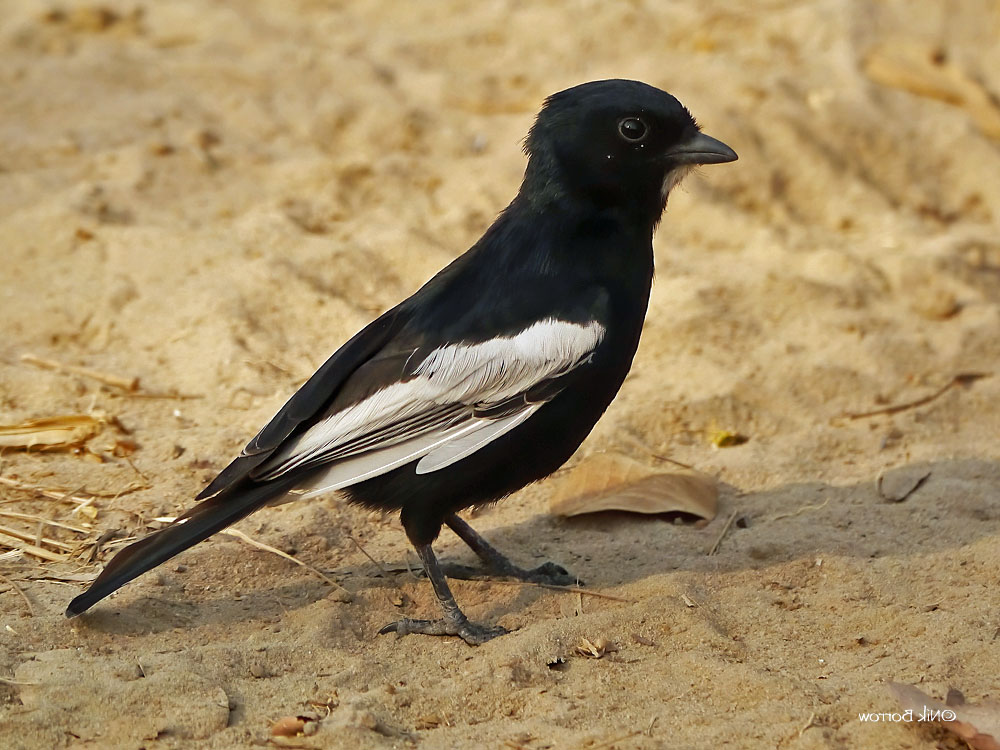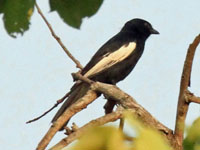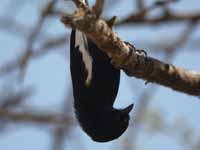The tits are a widespread family of birds, occurring over most of Europe, Asia, North America and Africa. They are active, noisy and social birds. The tits make a variety of calls and songs. The calls are generally the same between the sexes, but the male is much more vocal and the female rarely calls. Quiet calls are made while feeding to facilitate cohesion with others in their social group. Other calls are used for signalling alarm—the most famous of which is the "Chic-a-dee-dee" of North American. The number of "dee" syllables at the end of the call increases with the level of danger the predator poses.
The tits are generalist insectivores that consume a wide range of small insects and other invertebrates, particularly caterpillars. They also consume seeds and nuts, especially in the winter. Many species will cache the food for later use. One characteristic method of foraging in the family is hanging, where they will inspect a branch or twig and leaves from all angles while hanging upside down to feed.
There are 3 tit genera that contain only 1 species and these are not your typical tit: the sultan tit (Melanochlora sultanea) is about 20 cm long; the ground tit (Pseudopodoces humilis) also 20 cm long; and the yellow-browed tit (Sylviparus modestus) is about 9 cm long. Without these three exceptions, the tits range from 10 to 16 cm long and 7 to 30 grams of weight.
The tits of North America are all called titmouse (genus Baeolophus) and chickadees (genus Poecile).
The European, Asian, and African members of Paridae are all called tits.
There are no members of the family in South America or Australia.
NORTH AMERICAN TITS
Genus Baeolophus
The titmouse are found in North America, They have grey upperparts and white or grey underparts. All have a significant crest. They eat insects, seeds, nuts, and berries. They nest in cavities which are usually in trees. They do not excavate their own cavities and often used prior woodpecker cavities. They line their cavities with soft material such as moss. The titmouse species are 12 to 16 cm long.
Titmouse,_Black-crested also Mexican Titmouse Baeolophus atricristatus
Description: The black-crested titmouse has grey upperparts, rusty flanks, and whitish underparts. TThe male has a long dark crest; the female crest is not as dark. The black-crested titmouse is 14 to 15 cm long. Its call peter, peter, peter is similar to that of the tufted titmouse, but shorter. It makes its nest in existing tree cavities, often those made by woodpeckers, but it will also use bird boxes and other available cavities The black-crested titmouse was formerly a subspecies of the tufted titmouse.
Range: Texas, Oklanoma, Mexico.
Habitat: Areas where there are trees.
Diet: Berries, nuts, spiders, insects, and insect eggs.
Conservation status: Least Concern.
Image by: 1) Alan D Wilson 2) Dan Pancamo - Texas 3, 4) Andy_MorffewRange: Texas, Oklanoma, Mexico.
Habitat: Areas where there are trees.
Diet: Berries, nuts, spiders, insects, and insect eggs.
Conservation status: Least Concern.
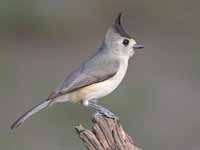
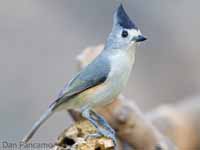
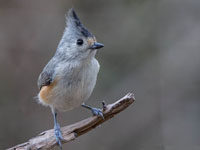

Titmouse,_ Bridled Baeolophus wollweberi
Description: The bridled titmouse has grey upperparts and white underparts. It has a white face with black striping, a grey and black crest, a black throat, and a short stout bill. It makes its nest in existing tree cavities, sometimes those made by woodpeckers. The bridled titmouse is about 12 cm long.
Range: Arizona, New Mexico, Mexico.
Habitat: Oak, oak-juniper forest, montane woodlands.
Diet: Insects, caterpillars. Also seeds, nuts, berries. They will cache food for later consumption.
Conservation status: Not a species.
Image by: 1, 2) Karla Kishinami - Arizona 3) Alan D Wilson 4) Dominic_SheronyRange: Arizona, New Mexico, Mexico.
Habitat: Oak, oak-juniper forest, montane woodlands.
Diet: Insects, caterpillars. Also seeds, nuts, berries. They will cache food for later consumption.
Conservation status: Not a species.
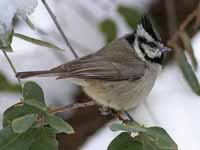
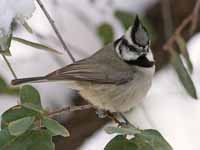

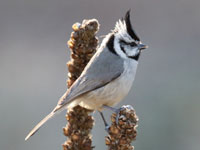
Titmouse,_ Juniper Baeolophus ridgwayi
Description: The juniper titmouse has grey upperparts, lighter grey underparts, and a small grey crest. It builds its nest in a woodpecker hole, natural cavity, or nest box, lining it with grass, moss, mud, hair, feathers, and fur. The juniper titmouse is up to 15 cm long. The oak titmouse and juniper titmouse appear almost identical, but differ in voice as well as range. Ranges overlap only in a small area in northen California.
Range: Southeastern Oregon and central Colorado south through Arizona and Texas to Mexico. Also eastern California.
Habitat: Open woodlands of warm, dry pinyon-juniper, juniper.
Diet: Insects and spiders. Also berries, acorns, and seeds. It can catch insects in the air.
Conservation status: Least Concern.
Image by: 1) Tony Randell 2) Seabamirum - Arizona 3) J N Stuart - Nevada 4) Ron_Knight - ColoradoRange: Southeastern Oregon and central Colorado south through Arizona and Texas to Mexico. Also eastern California.
Habitat: Open woodlands of warm, dry pinyon-juniper, juniper.
Diet: Insects and spiders. Also berries, acorns, and seeds. It can catch insects in the air.
Conservation status: Least Concern.
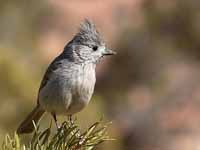

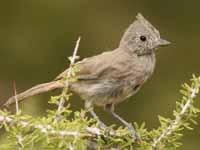
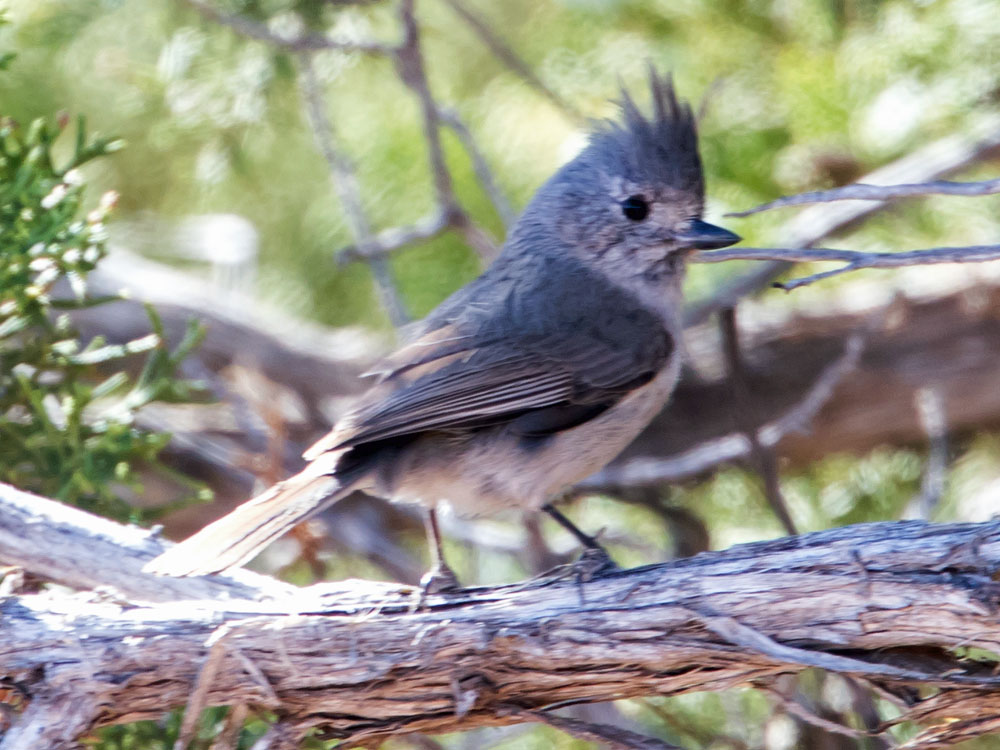
Titmouse,_Oak Baeolophus inornatus
Description: The oak titmouse has grey upperparts, lighter grey underparts, and a small grey crest. It builds its nest in a woodpecker hole, natural cavity, or nest box, lining it with grass, moss, mud, hair, feathers, and fur. The oak titmouse is up to 15 cm long. The oak titmouse and juniper titmouse appear almost identical, but differ in voice as well as range. Ranges overlap only in a small area in northen California. The oak titmouse is much more common than the juniper titmouse.
Range: Pacific slope from Oregon through California to Mexico.
Habitat: Open woodlands of oak and oak-pine.
Diet: Insects and spiders. Also berries, acorns, and seeds. It can catch insects in the air.
Conservation status: Least Concern.
Image by: 1) Alan Vernon - California 2) Gary Kramer, USFWS 3) Doug Greenberg - California 4) Velo Steve Range: Pacific slope from Oregon through California to Mexico.
Habitat: Open woodlands of oak and oak-pine.
Diet: Insects and spiders. Also berries, acorns, and seeds. It can catch insects in the air.
Conservation status: Least Concern.
1) Fledgling
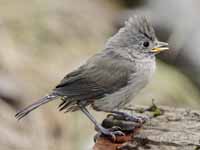


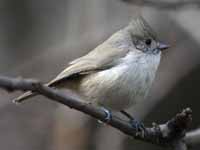
Titmouse,_ Tufted Baeolophus bicolor
Description: The tufted titmouse has grey upperparts including most of the head, It has a grey crest, dark forehead, and white face. The underparts are white with rust colored flanks. The tufted titmouse is up to 14 cm long. The black-crested titmouse was formerly a subspecies of the Tufted titmouse.
Range: Central and eastern United States.
Habitat: Deciduous and mixed woods as well as gardens, parks, and shrublands.
Diet: Insects, berries, nuts, seeds, caterpillars. It will stash food for later use.
Conservation status: Least Concern.
Image by: 1, 2, 3, 4) Dick Daniels - North Carolina Range: Central and eastern United States.
Habitat: Deciduous and mixed woods as well as gardens, parks, and shrublands.
Diet: Insects, berries, nuts, seeds, caterpillars. It will stash food for later use.
Conservation status: Least Concern.

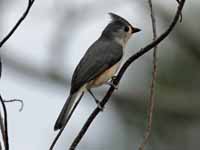
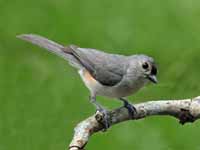

Genus Poecile
The genus Poecile has some species in North America and other in Europe and Asia. The North American species are called chickadees because of the call that sounds a lot like that name. Chickadees are able to let their body temperature drop considerably at night so as to conserve energy. The European and Asian species are all called tits.
Chickadee,_Black-capped Poecile atricapillus
Description: The black-capped chickadee has grey upperparts, a black cap, black throat, and white face/ The underparts are white with rusty brown flanks. The black-capped chickadee is up to 15 cm long. It is very similar to the Carolina chickadee, location is the best identifier. The black-capped wing feathers have white edges that are larger and more conspicuous than those of the Carolina Chickadee.
Range: From Alaska east to the Atlantic coast and south to about the middle of the United States.
Habitat: Deciduous and mixed forests. Very tolerant of people and a frequent visitor to bird feeders.
Diet: Insects, especially caterpillars, spiders, seeds, fruit. Can catch flies in the air.
Conservation status: Least Concern.
Image by: 1) Brendan Lally - British Columbia 2) Mdf - Algonquin Provincial Park, Canada 3) Alan D Wilson - British Columbia 4) Dick Daniels - New Hampshire 7) Dick - Olympia, WashingtonRange: From Alaska east to the Atlantic coast and south to about the middle of the United States.
Habitat: Deciduous and mixed forests. Very tolerant of people and a frequent visitor to bird feeders.
Diet: Insects, especially caterpillars, spiders, seeds, fruit. Can catch flies in the air.
Conservation status: Least Concern.
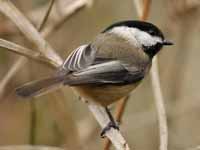

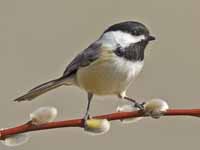
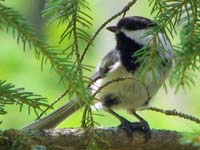
Chickadee,_Boreal Poecile hudsonicus
Description: The boreal chickadee has grey-brown upperparts, a brown cap, greyish wings, and greyish tail. The face is grey with white on the sides. It has white underparts, brown flanks, and a black face. The boreal chickadee is up to 14 cm long. The similar grey-headed chickadee has a greyish brown head, compared to the boreal's brown cap. Their ranges overlap only in Alaska and northwest Canada.
Range: Northern Canda and southern USA.
Habitat: Boreal forests. Very tolerant of people.
Diet: Mainly insects and seeds, which can be cached for later use. Forage on conifer branches and probe bark for food.
Conservation status: Least Concern.
Image by: 1, 2) David Mitchell 3) pbonenfant 4) Daniel_ArndtRange: Northern Canda and southern USA.
Habitat: Boreal forests. Very tolerant of people.
Diet: Mainly insects and seeds, which can be cached for later use. Forage on conifer branches and probe bark for food.
Conservation status: Least Concern.
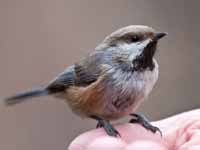
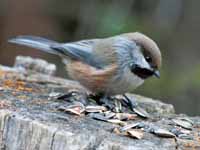
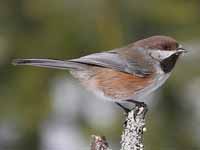
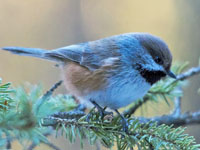
Chickadee,_Carolina Poecile carolinensis
Description: The Carolina chickadee has grey upperparts, a black cap, and black throat. It has a white face and white underparts with rusty brown flanks. The Carolina chickadee is about 12 cm long. It is similar to the black-capped chickadee which has white edges to the wings that are larger and more conspicuous than those of the Carolina chickadee.
Range: Southeast USA.
Habitat: Woodlands. Very tolerant of people.
Diet: Mainly insects, except in the winter they are placed by seeds and berries.
Conservation status: Least Concern.
Image by: 1) Norm Townsend - Oklahoma 2, 3, 4 Dick - North Carolina Range: Southeast USA.
Habitat: Woodlands. Very tolerant of people.
Diet: Mainly insects, except in the winter they are placed by seeds and berries.
Conservation status: Least Concern.
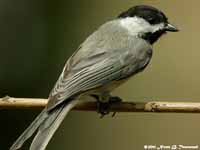
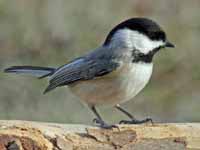
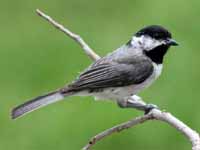
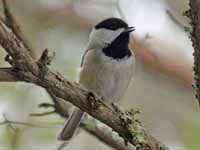
Chickadee,_Chestnut-backed Poecile rufescens
Description: The chestnut-backed chickadee has a chestnut colored back and flanks which easily differentiates this species from other chickadees. The amount of chestnut on its sides varies, those in coastal California may have no chestnut on their sides. It has a blackish-brown head with white face The underparts are white to greyish-white. The chestnut-backed chickadee is about 12 cm long.
Range: Northwest North America relatively close to the coast.
Habitat: Coniferous forests and their edges.
Diet: Insects, larvae, spiders. Also seeds.
Conservation status: Least Concern.
Image by: 1) Elaine R Wilson - British Columbia 2) Eugene Beckes 3) Maggie Smith - California 4) Eugene_BeckesRange: Northwest North America relatively close to the coast.
Habitat: Coniferous forests and their edges.
Diet: Insects, larvae, spiders. Also seeds.
Conservation status: Least Concern.
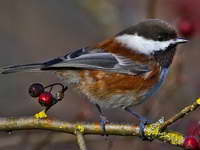

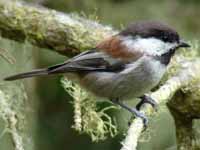
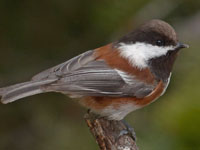
Chickadee,_Grey-headed Poecile cinctus
Description: The grey-headed chickadee, also treated below as the Siberian tit, has a dark greyish-brown head with white cheeks, brown mantle, blackish wing feathers with pale fringes, and a black throat. It has whitish underparts with pale brown flanks. The grey-headed chickadee is about 14 cm long. The similar boreal chickadee has a browner head. Their ranges overlap only in Alaska and northwest Canada.
Range: Northwest North America, Scandinvaian Europe, Asia.
Habitat: Lowland coniferous forests, especially old growth.
Diet: Insects, larvae, spiders, seeds.
Conservation status: They are still listed as Least Concern, but the population has declined substantially from decreased vegetation due to climate change, and logging of old-growth trees which are preferred over new-growth trees.
Image by: 1) Estormiz - Kittilä, Finland 2 - Ron Knight - Finland 3) Sergey Yeliseev - Altai, Russia 4) Crotach - FinlandRange: Northwest North America, Scandinvaian Europe, Asia.
Habitat: Lowland coniferous forests, especially old growth.
Diet: Insects, larvae, spiders, seeds.
Conservation status: They are still listed as Least Concern, but the population has declined substantially from decreased vegetation due to climate change, and logging of old-growth trees which are preferred over new-growth trees.

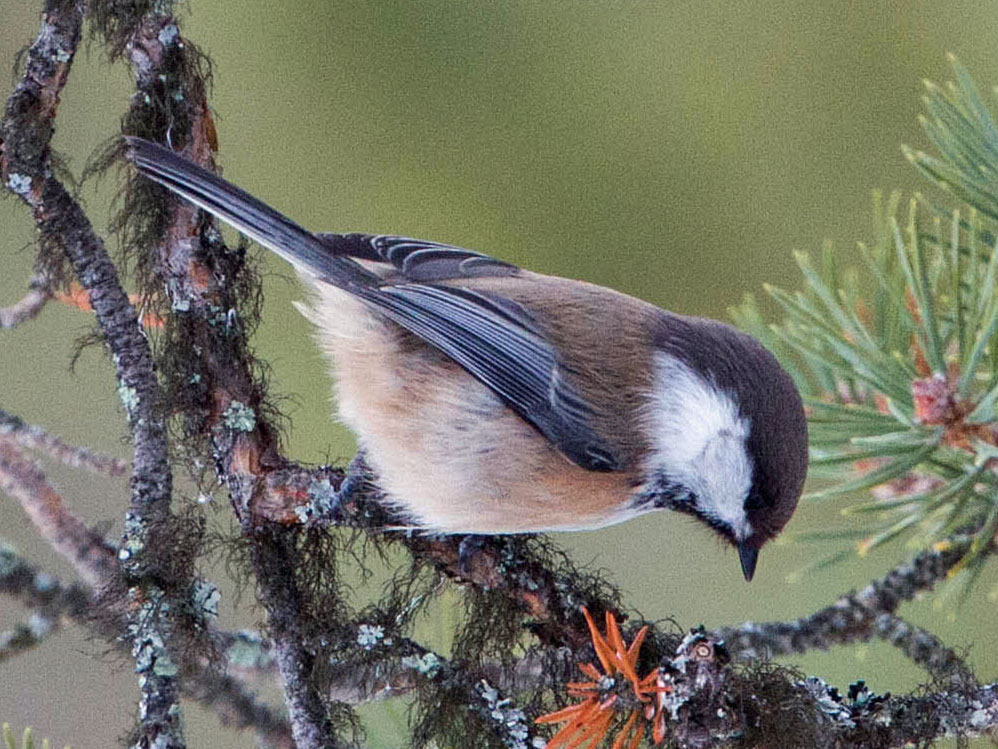
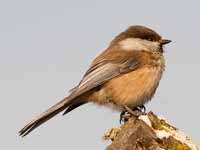
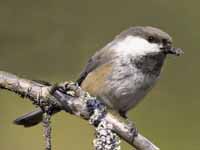
Chickadee,_Mexican Poecile sclateri
Description: The Mexican chickadee has a black cap, throat, and bill. It has white cheeks, a grey back, grey flanks, and paler grey underparts. The Mexican chickadee is about 13 cm long. Although primarily nonmigratory, Mexican chickadees sometimes fly to lower elevations during the cold of winter. Even though there is little range overlap with similar chickadees, it can be differentiate from vagrants by it larger black bib. Also, it does not make a chickadee sounding call.
Range: Southwest USA, Mexico.
Habitat: Usually montane evergreen forests and mixed oak forests.
Diet: Mainly insects, especially caterpillars.
Conservation status: Least Concern.
Image by: 1, 2) HarmonyonPlanetEarth - Arizona 3) Marcel Holyoak - southeast Arizona 3Range: Southwest USA, Mexico.
Habitat: Usually montane evergreen forests and mixed oak forests.
Diet: Mainly insects, especially caterpillars.
Conservation status: Least Concern.
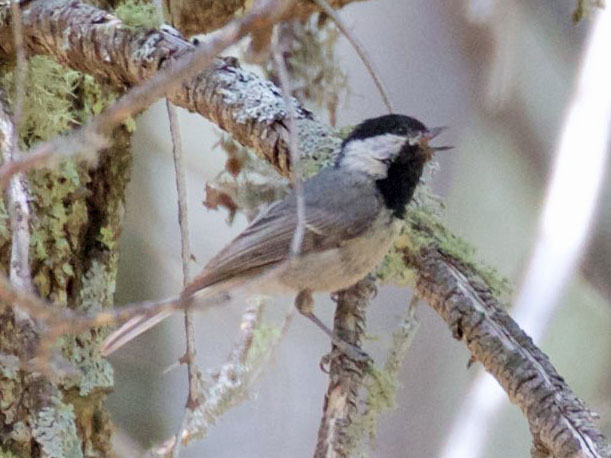
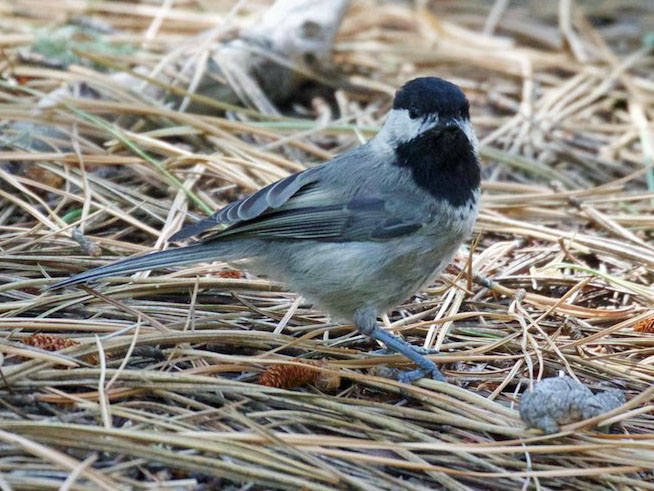

Chickadee,_Mountain Poecile gambeli
Description: The mountain chickadee has white eyebrows that differentiate it from other chickadees, except the white eyebrow may require closer inspection for worn adults. It has a narrow black crown, mask, and bib. The upperparts are grey and the underparts whitish. The mountain chickadee is about 12 cm long.
Range: Western USA and Canada.
Habitat: Montane coniferous forests, mixed forests.
Diet: Insects during breeding season. Also spiders. Seeds during the winter.
Conservation status: Least Concern.
Image by: 1) Jessi Bryan - Washington 2, 3) Jerry Oldenettel - New Mexico 4) Alan D Wilson - Oregon Range: Western USA and Canada.
Habitat: Montane coniferous forests, mixed forests.
Diet: Insects during breeding season. Also spiders. Seeds during the winter.
Conservation status: Least Concern.

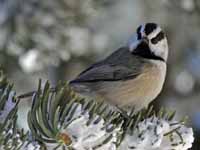

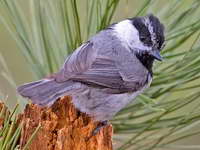
EURASIAN TITS
Tit,_Black-bibbed Poecile hypermelaenus
Description: The black-bibed tit has grey upperparts with white edgings to the wing and tail feathers. It has a black crown that extends to below the eyes and a small black bib. It has a white face and the rest pf the underparts are also white except for grey flanks. The black-bibed tit is about 12 cm long.
Range: Central and eastern China to southeast Tibet and western Myanmar.
Habitat: Conifer forests or mixed forests. Also broadleaf forests.
Diet: Insects, seeds, berries.
Conservation status: Least Concern.
Image by:
1) Gustav_Mutzel 2, 3) LonelyShrimpRange: Central and eastern China to southeast Tibet and western Myanmar.
Habitat: Conifer forests or mixed forests. Also broadleaf forests.
Diet: Insects, seeds, berries.
Conservation status: Least Concern.
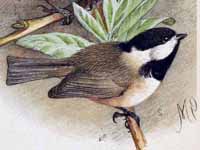

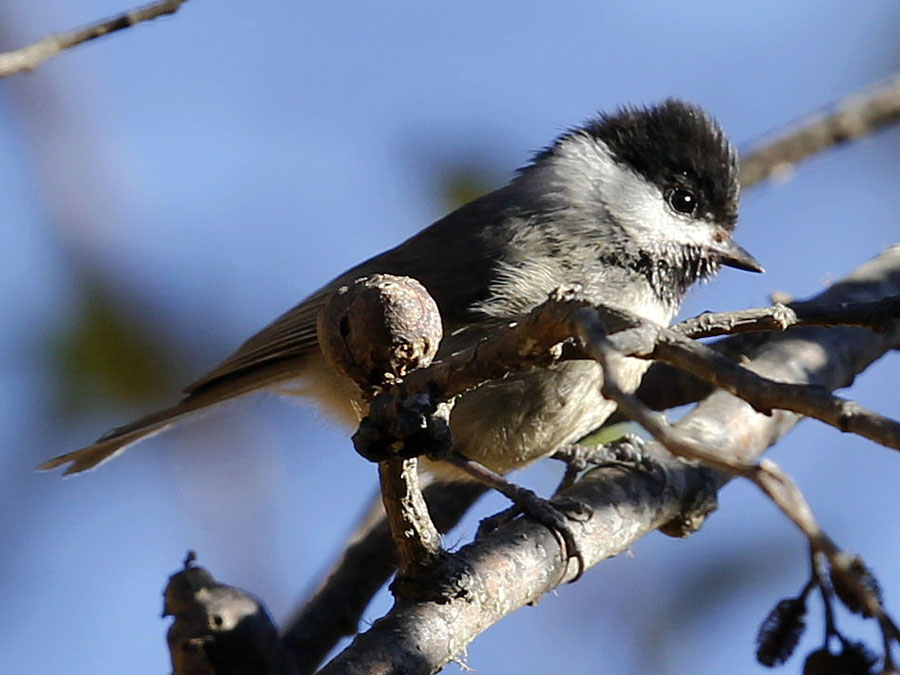
Tit,_Marsh Poecile palustris
Description: The marsh tit has a black crown, nape, and chin plus pale cheeks. The mantle is usually brown but may be brownish grey. It has greyish-brown wings, and tail. The underparts are white with buff flanks. The similar willow tit is very difficult to tell from the marsh tit which usually has browner upperparts and a glossier dark head.
Range: Temperate Europe and northern Asia.
Habitat: Various habits including dry woodlands (inspite of its name). Prefers deciduous or mixed woodlands.
Diet: Insects, spiders, fruits, seeds.
Conservation status: Least Concern.
Image by: 1) Steffen Hannert 2) Luc Viatour 3) Slawomir Staszczuk 4) Cristiano Crolle - Cesano Maderno, Italy Range: Temperate Europe and northern Asia.
Habitat: Various habits including dry woodlands (inspite of its name). Prefers deciduous or mixed woodlands.
Diet: Insects, spiders, fruits, seeds.
Conservation status: Least Concern.
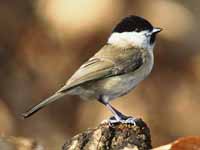

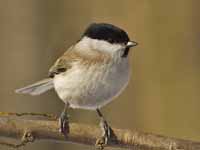
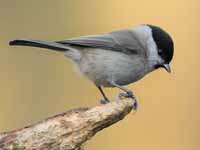
Tit,_Pere_David's Poecile davidi
Description: The Pere David's tit has dark grey-brown upperparts including the wings and tail. It has a black head and throat, white cheeks, and rusty-brown underparts. The Pere David's tit is up to 13 cm long.
Range: Central China.
Habitat: Subalpine forests.
Diet: Probably insects, larvae, and seeds.
Conservation status: Least Concern.
Image by: 1) Gustav_Mutzel Range: Central China.
Habitat: Subalpine forests.
Diet: Probably insects, larvae, and seeds.
Conservation status: Least Concern.

Tit, Siberian Poecile cinctus
Description: The Siberian tit, also treated above as the grey-headed chickadee, has a dark greyish-brown head with white cheeks, brown mantle, blackish wing feathers with pale fringes, and a black throat. It has whitish underparts with pale brown flanks. The Siberian tit is about 14 cm long. The similar boreal chickadee has a browner head. Their ranges overlap only in Alaska and northwest Canada.
Range: Northwest North America, Scandinvaian Europe, Asia.
Habitat: Lowland coniferous forests, especially old growth.
Diet: Insects, larvae, spiders, seeds.
Conservation status: They are still listed as Least Concern, but the population has declined substantially from decreased vegetation due to climate change, and logging of old-growth trees which are preferred over new-growth trees.
Image by: 1) Estormiz - Kittilä, Finland 2 - Ron Knight - Finland 3) Sergey Yeliseev - Altai, Russia 4) Crotach - FinlandRange: Northwest North America, Scandinvaian Europe, Asia.
Habitat: Lowland coniferous forests, especially old growth.
Diet: Insects, larvae, spiders, seeds.
Conservation status: They are still listed as Least Concern, but the population has declined substantially from decreased vegetation due to climate change, and logging of old-growth trees which are preferred over new-growth trees.




Tit,_Sichuan Poecile weigoldicus
Description: The Sichuan tit has a blackish-brown crown, nape, and chin. The face is pale. The mantle is greyish-brown with darker wings. The underparts are white with buff flanks. The Sichuan used to be a subspecies of the willow tit.
Range: Central China.
Habitat: Montane coniferous forests.
Diet: Probably insects, larvae, and seeds.
Conservation status: Least Concern.
Image by: 1, 2) Dave CurtisRange: Central China.
Habitat: Montane coniferous forests.
Diet: Probably insects, larvae, and seeds.
Conservation status: Least Concern.
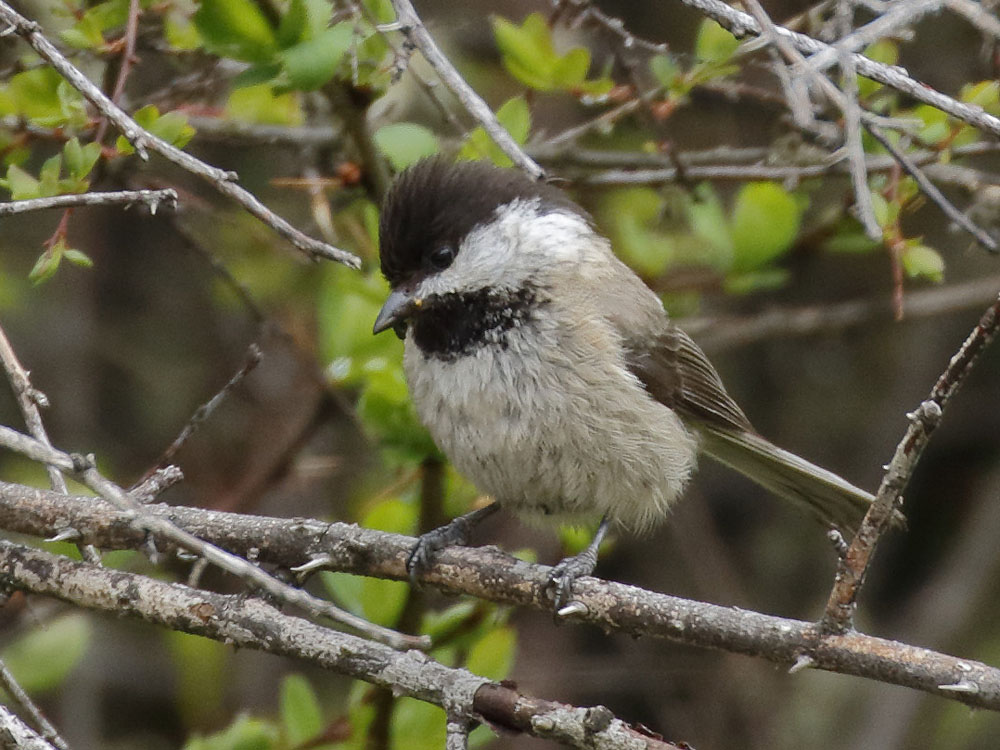

Tit,_Sombre Poecile lugubris
Description: The sombre tit has greyish-brown upperparts with white edging to the wings. It has a black cap, white face, and black bib. The underparts are whitish with a buffy wash. The sombre tit is up to 15 cm long, which is large for a tit.
Range: Southeast Europe, southwest Asia.
Habitat: Dry areas in open woodlands.
Diet: Insects, larvae. Forages low in trees, on brush, and sometimes catches an insect on the ground..
Conservation status: Least Concern.
Image by: 1) Steve Raill - Bulgalia 2) Steve_Riall - Bulgaria 3) Nikola_Veljkovic - southwest SerbiaRange: Southeast Europe, southwest Asia.
Habitat: Dry areas in open woodlands.
Diet: Insects, larvae. Forages low in trees, on brush, and sometimes catches an insect on the ground..
Conservation status: Least Concern.
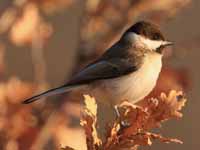
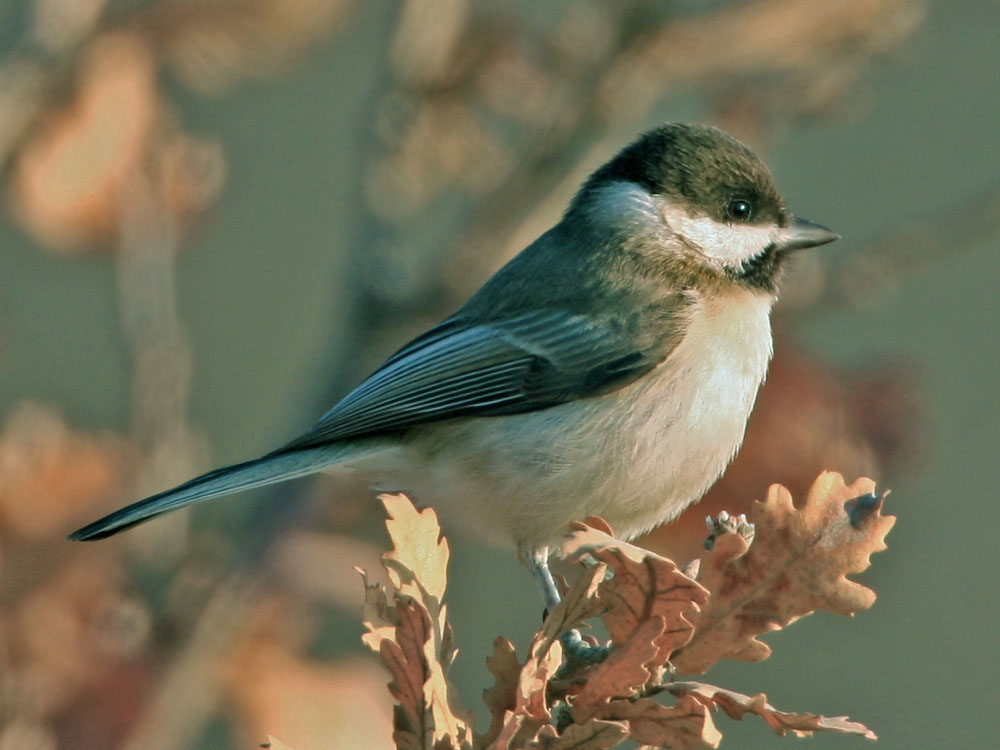
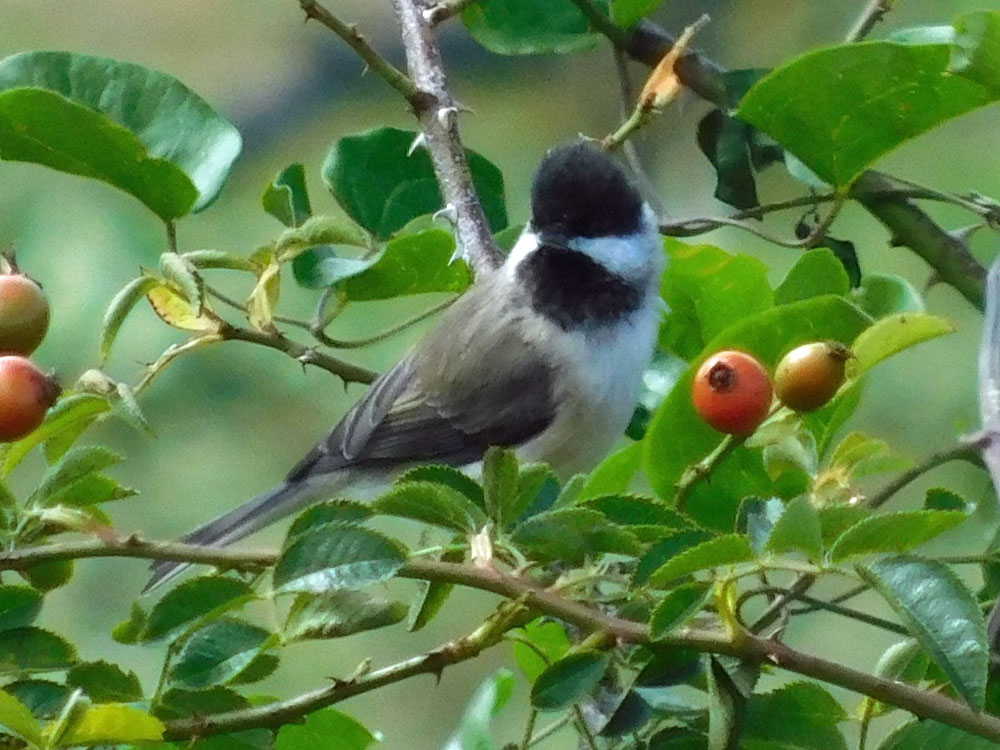
Tit,_White-browed Poecile superciliosus
Description: The white-browed tit has greyish-green or greyish-brown upperparts. It has a black cap, white supercilium, black eye-line, and black chin. The face and underparts are pinkish-brown. The white-browed tit is about 14 cm long.
Range: Southwestern China and Tibet.
Habitat: Mountain forests.
Diet: Insects, larvae, seeds.
Conservation status: Least Concern.
Image by: 1) Dave_CurtisRange: Southwestern China and Tibet.
Habitat: Mountain forests.
Diet: Insects, larvae, seeds.
Conservation status: Least Concern.
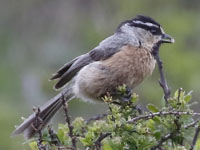
Tit,_Willow Poecile montanus
Description: The willow tit has a black cap, nape, and chin. The cheeks are pale. It has a greyish-brown back, wings, and tail. The underparts are pale buff. The willow tit is up to 12 cm long. It excavates the nest in dead wood. There are 6 to 9 eggs, that high number necessary to compensate for a 50% mortality rate the first year and a 3 year life expectancy after that. The simialr marsh tit is very difficult to tell from the willow tit. The marsh tit usually has browner upperparts and a glossier dark head.
The songar tit (P. m. songarus) is sometimes considered to be a separate species instead of a subpecies of the willow tit. It has has light brown upperparts, dark brown cap, blackish chin, white cheeks, cinnamon buff underparts. It is found in the vicinity of Kyrgyzstan.
Range: Mainly eastern Europe including Great Britian, but found across Asia and even Japan.
Habitat: Mainly conifers which allows it to range further north than the marsh tit.
Diet: Insects, larvae, and seeds.
Conservation status: Least Concern.
Image by: 1) Baresi Franco 2) Cristiano Crolle - Switzerland 3) Estormiz - Finland 4) Sergey Yeliseev - Kazakhstan (P. m. songarus)The songar tit (P. m. songarus) is sometimes considered to be a separate species instead of a subpecies of the willow tit. It has has light brown upperparts, dark brown cap, blackish chin, white cheeks, cinnamon buff underparts. It is found in the vicinity of Kyrgyzstan.
Range: Mainly eastern Europe including Great Britian, but found across Asia and even Japan.
Habitat: Mainly conifers which allows it to range further north than the marsh tit.
Diet: Insects, larvae, and seeds.
Conservation status: Least Concern.
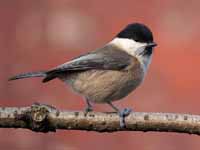
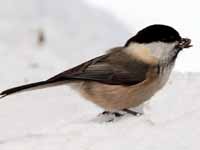


Genus Cephalopyrus - 1 species
Tit,_Fire-capped Cephalopyrus flammiceps
Description: The fire-capped tit has yellowish to olive-green upperparts with a dark olive-brown tail. The wings are olive-brown with yellowish edgings. The underparts are yellow with grey flanks.
During breeding season the male fire-capped tit has an orange-red crest. The fire-capped tit is about 9 cm long, very small for a tit.
Range: Along the Himilayas of China, Myanmar, and Nepal.
Habitat: Deciduous and mixed woods as well as gardens, parks, and shrublands.
Diet: Insects. Also buds, flowers, and leaves
Conservation status: Least Concern.
Image by:
1) Francesco_Veronesi - Bhutan 2) Ron Knight 3) Savithri_SinghRange: Along the Himilayas of China, Myanmar, and Nepal.
Habitat: Deciduous and mixed woods as well as gardens, parks, and shrublands.
Diet: Insects. Also buds, flowers, and leaves
Conservation status: Least Concern.
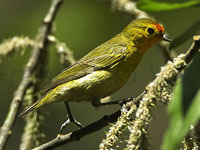
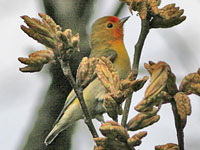
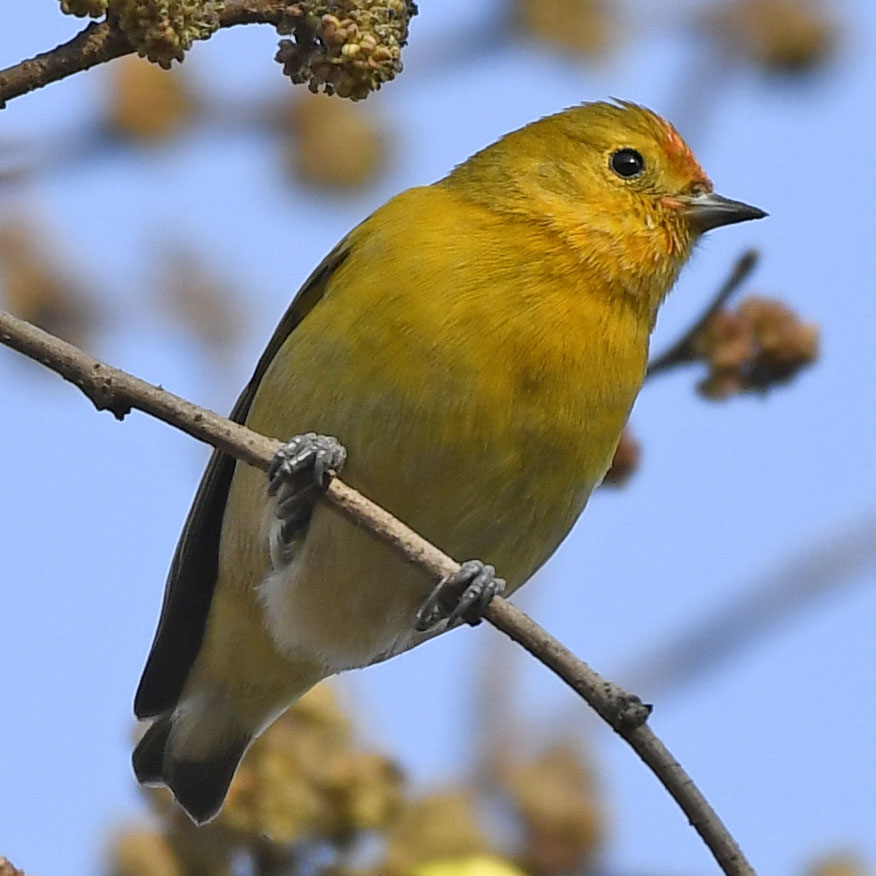
Genus Cyanistes
As the name implies, species belonging to the genus Cyanistes are known for their blue plumage. Except for the African blue tit, these are Eurasian birds. They are 11 to 13 cm long. The diet consists of Insects, their larvae and eggs, seeds. Caterpillars are important during the breeding season. The females usually makes her nest in a tree cavity. The male reciprocates by feeding her while she incubates the egss.
Tit,_African Blue Cyanistes teneriffae
Description: The African blue tit has blue upperparts including its cap, wings, and tail. It has a white face with a black eye-line. The throat is black, there is a black collar, and there is a black median on the underparts which are yellowish. The African blue tit is about 11 cm long.
Range: Northern Africa, Canary Islands.
Habitat: Woodlands and scrublands.
Diet: Ants, aphids, caterpillars, and other insects.
Conservation status: Least Concern.
Image by: 1, 2, 3, 4) Juan Emilio - Canary Islands Range: Northern Africa, Canary Islands.
Habitat: Woodlands and scrublands.
Diet: Ants, aphids, caterpillars, and other insects.
Conservation status: Least Concern.
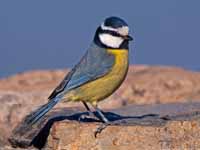
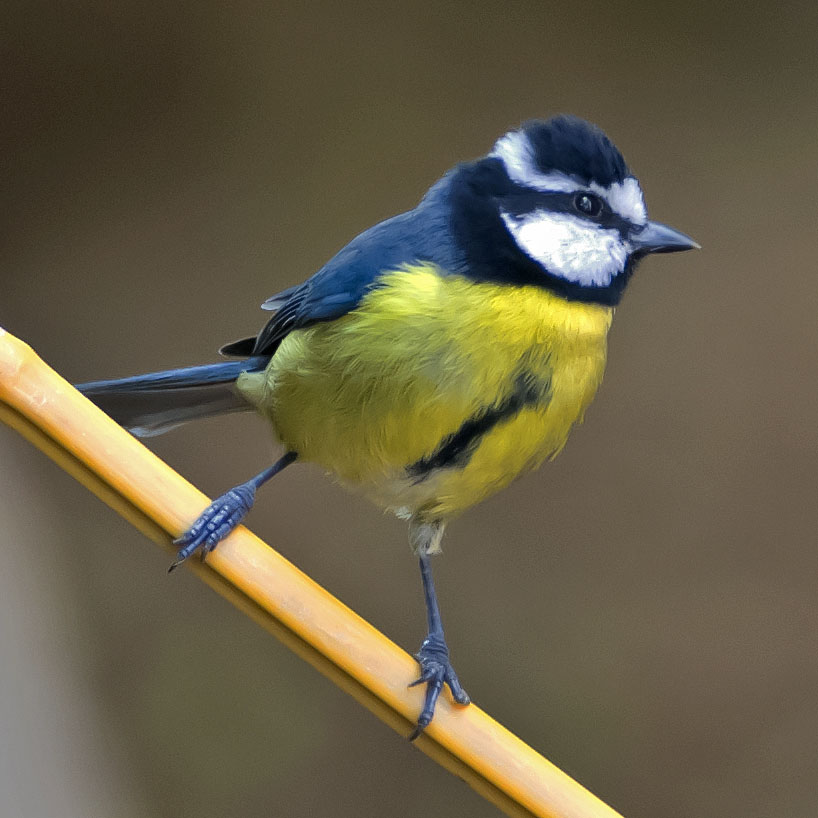

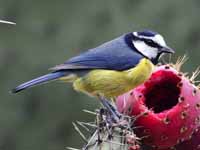
Tit,_Azure Cyanistes cyanus
Description: The azure tit has blue upperparts including the upper-tail. It has bold white wing-bars, a white head, and white underparts. There are dark but thin eye-lines that join behind the head and continue down the nape. The nest is made by the female in a cavity, usually that of a tree, by placing soft material such as moss there. The azure tit is about 13 cm long. It is the eastern counterpart of the Eurasian blue tit - in fact, they will from hybrids.
Range: Russia and Central Asia and northwest China, Manchuria and Pakistan.
Habitat: Woodlands and areas with sparse trees.
Diet: Insects, their larvae and eggs, seeds, small invertebrates.
Conservation status: Least Concern.
Image by: 1, 2) Sergey Pisarevskiy - South Siberia, Russia 3) Ron_Knight 4) Jargal_LamjavRange: Russia and Central Asia and northwest China, Manchuria and Pakistan.
Habitat: Woodlands and areas with sparse trees.
Diet: Insects, their larvae and eggs, seeds, small invertebrates.
Conservation status: Least Concern.
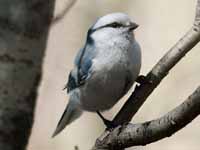
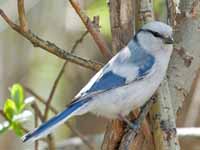
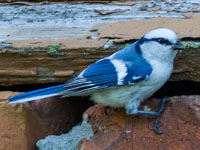

Tit,_Eurasian Blue Cyanistes caeruleus
Description: The Eurasian blue tit, also known as the blue tit, has a blue cap, wings,and tail. It has a yellow-green mantle, white face, black eye-line, and yellowish underparts. The Eurasian blue tit is 11 to 12 cm long. It is the western counterpart of the Azure blue tit - in fact, they will from hybrids.
Range: Europe, western Asia.
Habitat: Woodlands, especially those with oaks.
Diet: Mainly insects and spiders. Also seeds.
Conservation status: Least Concern.
Image by: 1) Jan_Svetlik 2) Tapio Kaisla 3) Andreas Trepte 4) Luc ViatourRange: Europe, western Asia.
Habitat: Woodlands, especially those with oaks.
Diet: Mainly insects and spiders. Also seeds.
Conservation status: Least Concern.

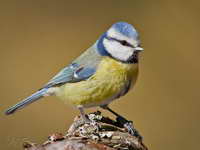


Tit,_Yellow-breasted Cyanistes flavipectus
Description: The yellow-breasted tit is usually considered to be a subspecies of the Azure blue tit. It has blue upperparts, off-white head with dark eye-line, yellow-breast, and off-white belly with black center line.
Range: Asia.
Habitat: Woodlands and areas with sparce trees.
Diet: Insects, their larvae and eggs, seeds, small invertebrates.
Conservation status: Least Concern.
Image by: 1, 2) Francesco Veronesi - UzbekistanRange: Asia.
Habitat: Woodlands and areas with sparce trees.
Diet: Insects, their larvae and eggs, seeds, small invertebrates.
Conservation status: Least Concern.

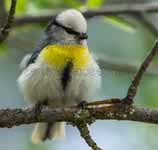
Genus Lophophanes
These two species of tits with crests look quite similar, but are widely sperated by thousands of kilometers.
Tit,_Crested Lophophanes cristatus
Description: The crested tit has grey-brown upperparts including the upper-tail. It has a black and white crest, white face with black eye-line that curls back around the ear-coverts. The throat is black with a black collar. The underparts are white with buffy-grey on the flanks. The crested tit is about 12 cm long. The nest is usually built in a tree cavity by the female using soft material such as moss or animal hair. The cavity may be existing such as a woodpecker hole, but it may also be created and or enlarged by the female with some help from the male.
Range: Central and northern Europe.
Habitat: Prefers conifer forests or mix deciduous and evergreen forests.
Diet: Insects and their larvae. Also small invertebrates and fruits during non-breeding seasons.
Conservation status: Least Concern.
Image by: 1) Tapio Kaisla 2) Luc
Viatour (CC BY-SA 3.0) 3) Cristiano Crolle - Val Roseg, Switzerland 4) Sgbeer Range: Central and northern Europe.
Habitat: Prefers conifer forests or mix deciduous and evergreen forests.
Diet: Insects and their larvae. Also small invertebrates and fruits during non-breeding seasons.
Conservation status: Least Concern.

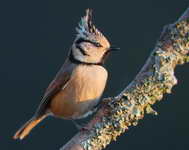
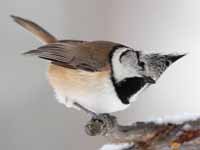
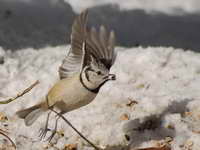
Tit,_grey-crested Lophophanes dichrous
Description: The grey-crested tit has grey upperparts, head, and crest. The tail is a darker grey. It has a white malar stripe that continues to blend with a white collar. The throat is also white and the underparts are white or buffy. The grey-crested tit is about 12 cm long.
Range: Himalayan foothills and southern-central China.
Habitat: Prefers conifer forests or mix deciduous and evergreen forests. Also bamboo.
Diet: Mainly insects, other arthropods and their larvae.
Conservation status: Least Concern.
Image by: 1) soumyajit_nandy 2) Garima_Bhatia - Bhutan 3) Dave_Curtis 4) PJeganathanRange: Himalayan foothills and southern-central China.
Habitat: Prefers conifer forests or mix deciduous and evergreen forests. Also bamboo.
Diet: Mainly insects, other arthropods and their larvae.
Conservation status: Least Concern.

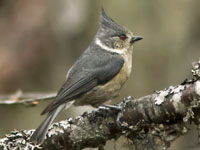
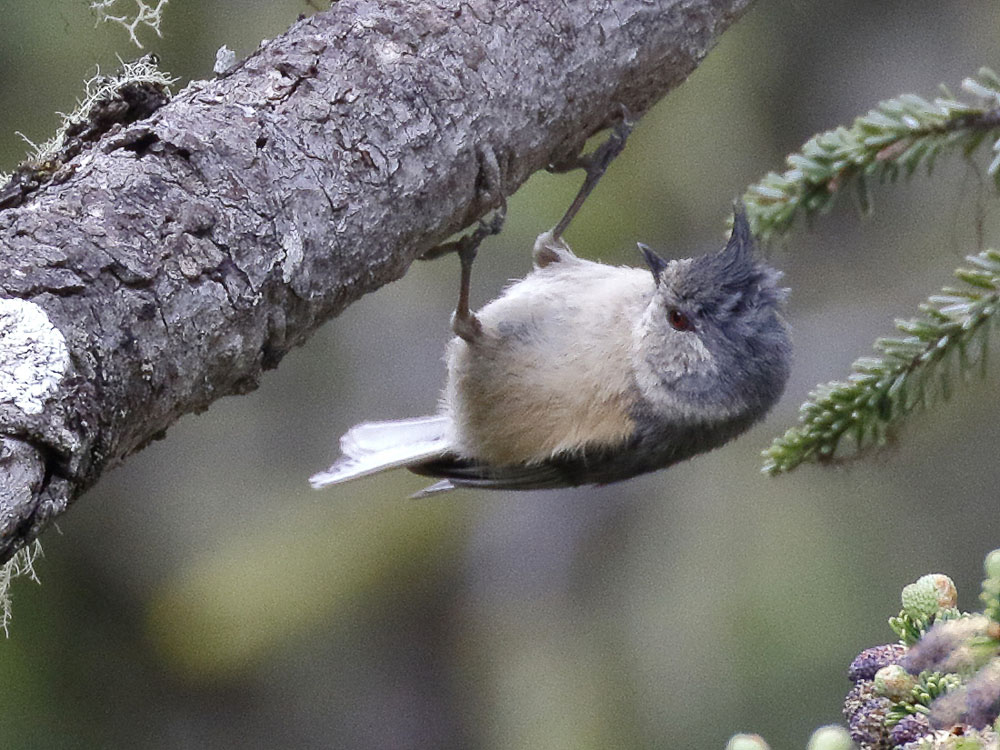
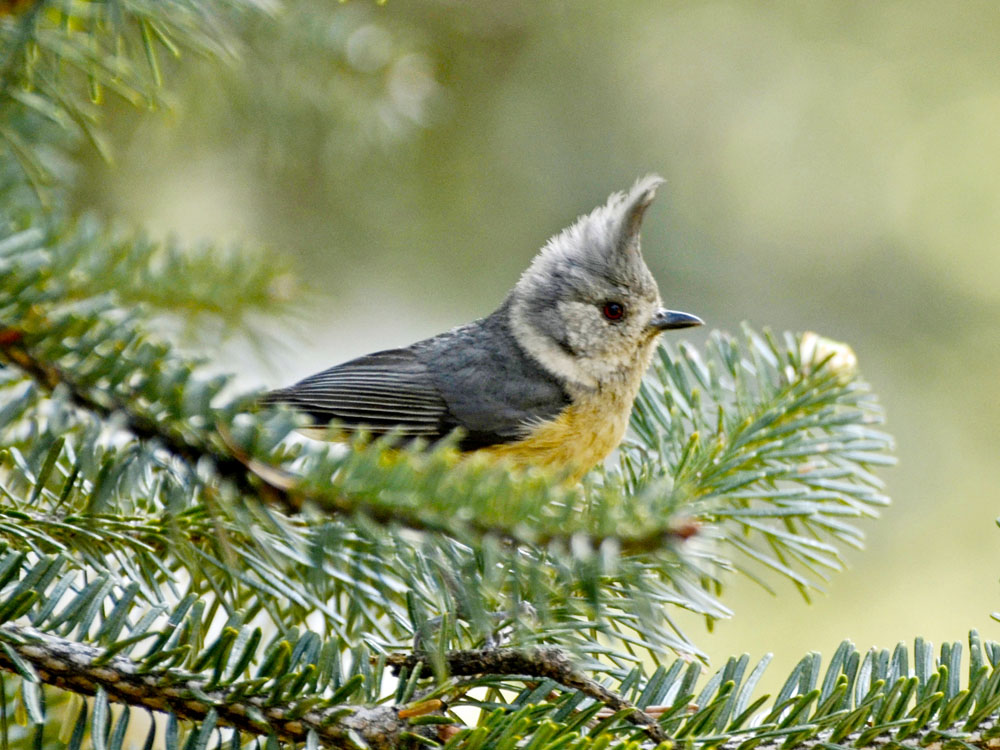
Genus Machlolophus
Except for the white-naped tit, these Asian species all have a prominent mainly black crest. Like other tits, they use a tree cavity for their nest sit and line it with soft material such as moss and fur.
Tit,_Himalayan_Black-lored Machlolophus xanthogenys
Description: The Himalayan black-lored tit, also known as the black-lored tit, has olive-green upperparts and a broad black line down its otherwise yellow underparts. It has black lores, crest, nape, and throat. It has a yellow face with a bold black eye-line. There are 2 white or yellowish wing-bars. The Himalayan black-lored tit and the Indian black-lored tit were previous treated as one species - the black-lored bit.
Range: Along the Himalayas from Pakistan through the Indian Sub-Continent to Bhutan.
Habitat: Mainly evergreen and oak forests.
Diet: Mainly insects and spiders; also fruit.
Conservation status: Least Concern.
Image by: 1) Shrikant_Rao - India 2, 4) Koshy_Koshy - India 3) Avyakta_Shashi - IndiaRange: Along the Himalayas from Pakistan through the Indian Sub-Continent to Bhutan.
Habitat: Mainly evergreen and oak forests.
Diet: Mainly insects and spiders; also fruit.
Conservation status: Least Concern.
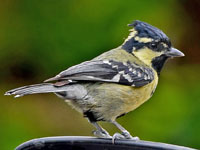


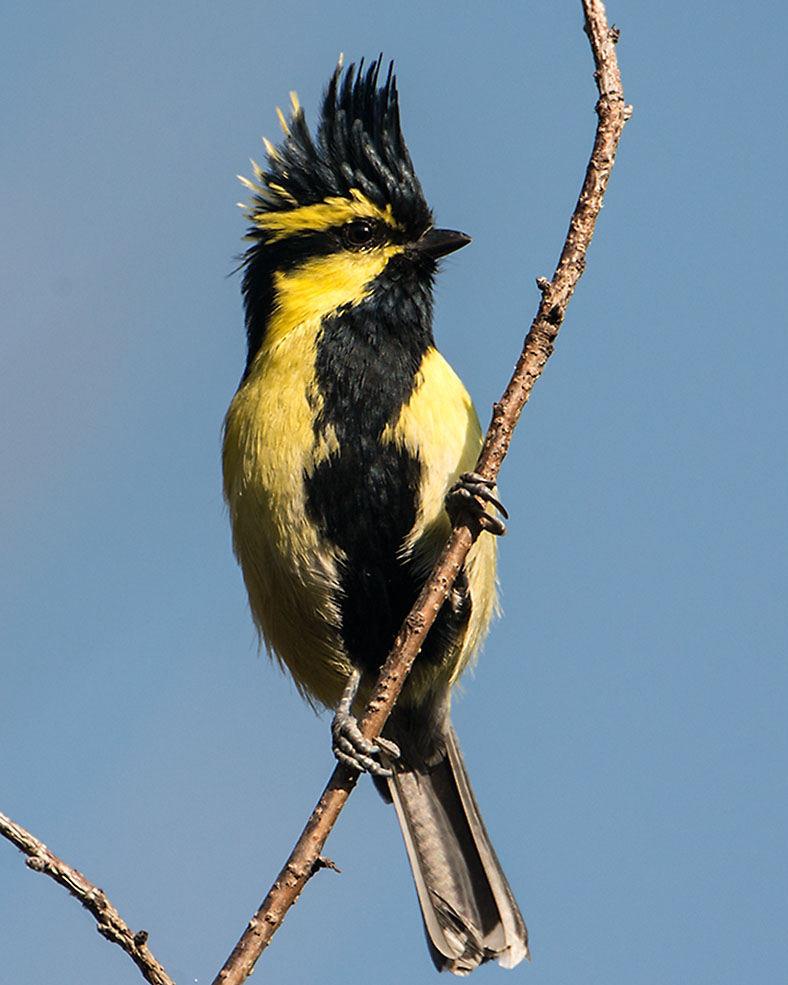
Tit,_Indian_Black-lored Machlolophus aplonotus
Description: The Indian black-lored tit, also known as the Indian yellow tit, has olive-green upperparts and a broad black line down its otherwise yellow underparts. It has black lores, crest, nape, and throat. It has a yellow face with a bold black eye-line. There are 2 white or yellowish wing-bars. The Himalayan black-lored tit and the Indian black-lored tit were previous treated as one species - the black-lored tit. The seems to be little if any difference between the two species, so perhaps they should be combined again. The best way to diffenetiate between them is: if in the Himilayas then Machlolophus xanthogenys else Machlolophus aplonotus.
Range: India,
Habitat: Mainly evergreen and oak forests; also bamboo.
Diet: Mainly insects and spiders; also fruit.
Conservation status: Least Concern.
Image by: 1) Sergey Yeliseev 2) Tarique San Uajith 4) PrajwalkmRange: India,
Habitat: Mainly evergreen and oak forests; also bamboo.
Diet: Mainly insects and spiders; also fruit.
Conservation status: Least Concern.
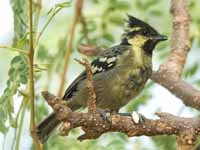
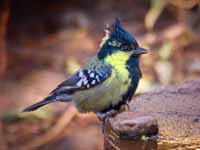
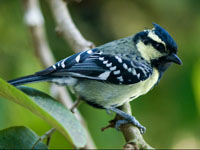
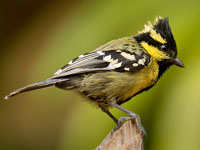
Tit,_White-naped Machlolophus nuchalis
Description: The white-naped tit, also known as the white-winged tit, has black-and-white plumage. It has black upperparts with white wings, narrow black nape surrounded by white, and white cheeks.The chin and throat are black. The underparts are white with a black stripe down underparts.
Range: Southern India and northwest India.
Habitat: Dry thorn scrub forest.
Diet: Spiders, insects, larvae. Also fruit and nectar.
Conservation status: It is listed as vulnerable because of a rapid population decline due to the Acacia shrub being destroyed.
Image by: 1) Tarique Sani 2) Dhaval_Vargiya 3) Parthkansara305Range: Southern India and northwest India.
Habitat: Dry thorn scrub forest.
Diet: Spiders, insects, larvae. Also fruit and nectar.
Conservation status: It is listed as vulnerable because of a rapid population decline due to the Acacia shrub being destroyed.
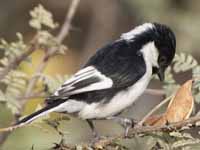
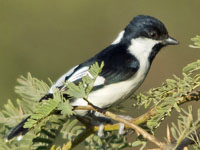
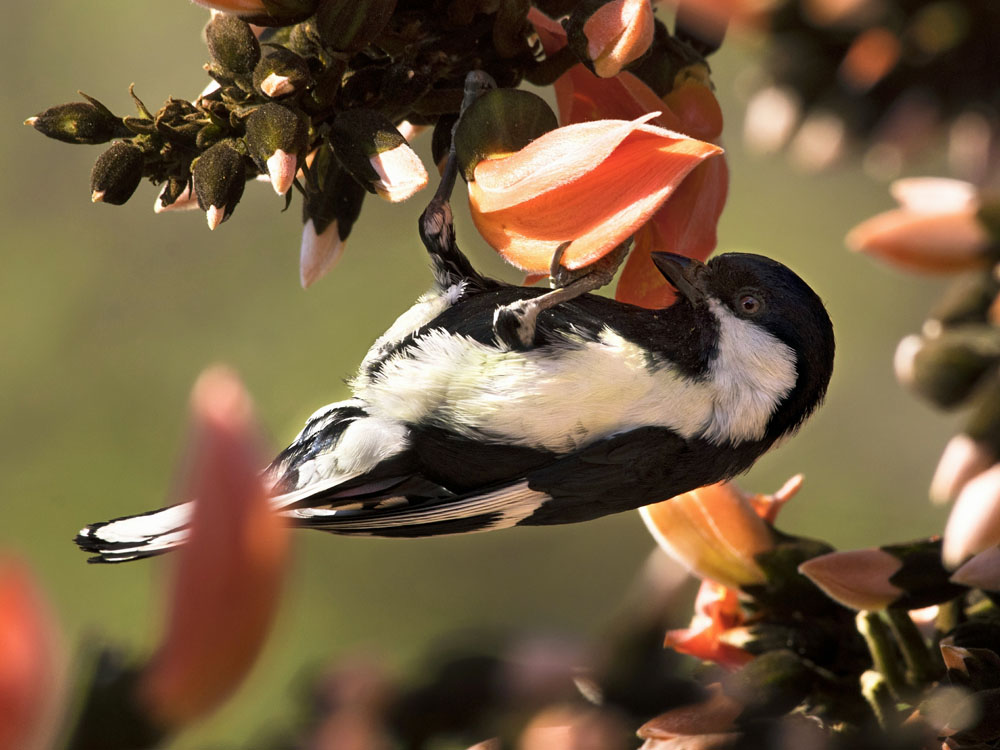
Tit,_Yellow Machlolophus holsti
Description: The yellow tit has mainly blackish-blue upperparts with a darker tail. The black crest has some white mixed in. It has small black lores, a yellow forehead, and yellow underparts. The yellow tit is 13 cm long.
Range: Taiwan.
Habitat: Montane temperate forest.
Diet: Insects, larvae, caterpillars, other arthropods.
Conservation status: It is listed as Near Threatened because of large scale capture for bird trade.
Image by: 1, 3) Hiyashi Halso 2)
Robert tdcRange: Taiwan.
Habitat: Montane temperate forest.
Diet: Insects, larvae, caterpillars, other arthropods.
Conservation status: It is listed as Near Threatened because of large scale capture for bird trade.


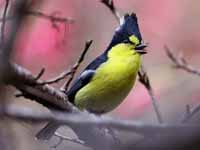
Tit,_Yellow-cheeked Machlolophus spilonotus
Description: The yellow-cheeked tit has black-and-white upperparts. It has a black crest, yellow cheeks, and a black eye-line that contines as an arc towards the yellow nape and then down to the shoulder. It has a black throat and a wide median black stripe down its otherwise yellow underparts. The yellow-cheeked tit is 14 to 15 cm long.
Range: Mainly southern China and the Malay peninsular. Also Bangladesh, Bhutan, Nepal.
Habitat: Mixed forest, especially with oak.
Diet: Insects, spiders, larvae; some fruit.
Conservation status: Least Concern.
Image by: 1) Ron Knight 2) Ron Hodgkinson 3) Francesco VeronesiRange: Mainly southern China and the Malay peninsular. Also Bangladesh, Bhutan, Nepal.
Habitat: Mixed forest, especially with oak.
Diet: Insects, spiders, larvae; some fruit.
Conservation status: Least Concern.
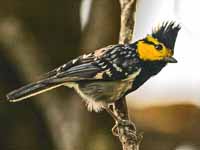


Genus Melanochlora - 1 species
Tit,_Sultan Melanochlora sultanea
Description: The male sultan tit has blue black upperparts, face, and upper-breast. It has a yellow crest, forehead, lower-breast, and belly The female has yellow parts that are duller and greenish-brown instead of black. The sultan tit is about 20 cm long.
Range: Southeast Asia.
Habitat: Forests, woodlands, bamboo.
Diet: Insects, spiders, fruit.
Conservation status: Least Concern.
Image by: 1, 2) Hiyashi Halso known as 3) Jerry Oldenettel - ThailandRange: Southeast Asia.
Habitat: Forests, woodlands, bamboo.
Diet: Insects, spiders, fruit.
Conservation status: Least Concern.
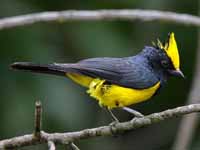
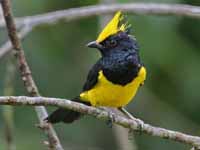

Genus Parus
The genus Parus formerly contained almost all the species of the tit family, but has been downsized to just four species. All of the species are found in Asia, but the great tit is also found extensively in Europe.
Tit,_Cinereous Parus cinereus
Description: The cinereous tit has grey upperparts with white edgings. It has a black hood, throat, and black median stripe on the underparts. The white cheeks as are the underparts. The cinereous tit is up to 15 cm long.
Range: Southern Asia, Indonesia, Malaysia
Habitat: Forests and their edges or clearing. Also mainly untreed places as long as there are some available.
Diet: Insects, larvae, seeds.
Conservation status: Least Concern.
Image by: 1) Raju Kasambe 2) TR_Shankar_Raman - India 3, 4) Imran_Shah - PakistanRange: Southern Asia, Indonesia, Malaysia
Habitat: Forests and their edges or clearing. Also mainly untreed places as long as there are some available.
Diet: Insects, larvae, seeds.
Conservation status: Least Concern.
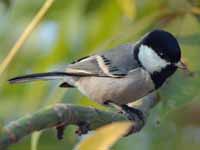
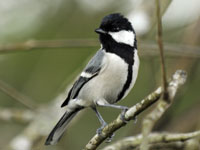

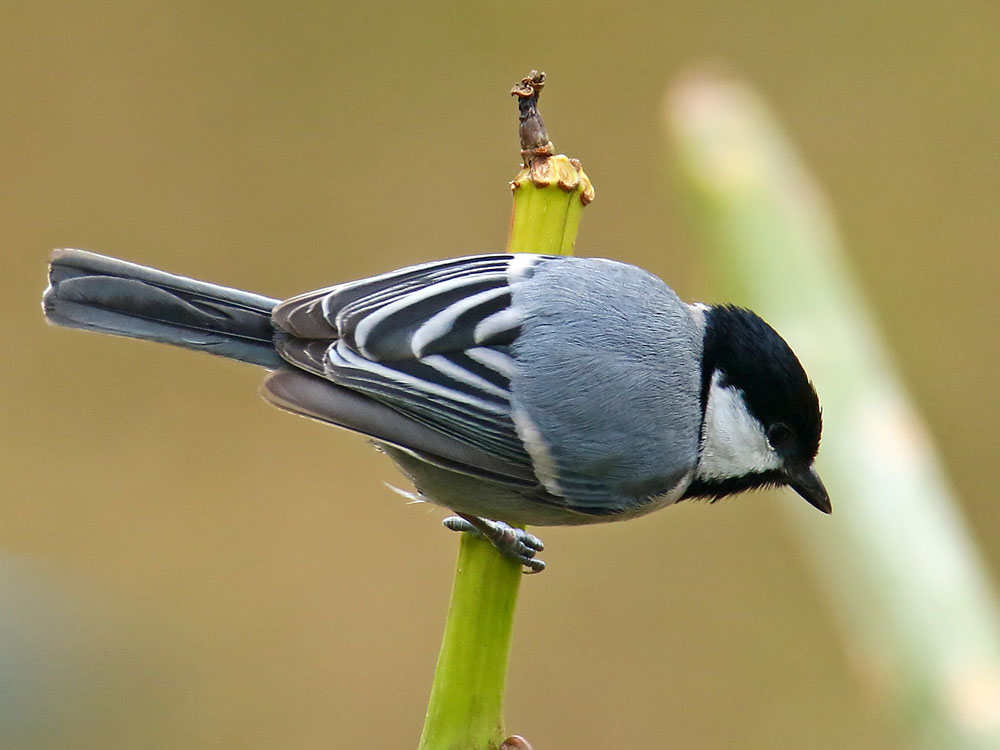
Tit,_Great Parus major
Description: The great tit has olive upperparts and yellow underparts. It has a black head, throat, median stripe on the underparts. The face is white. The great tit is up to 14 cm long.
Range: Europe, the Middle East, central Asia, northern Africa.
Habitat: Open deciduous woodland, mixed forests, forest edges and gardens.
Diet: Insects, larvae, spiders; also seeds and berries during the winter. The young are mainly fed caterpillars.
Conservation status: Least Concern.
Image by: 1) Jacques Chibret 2) Slawomir
Staszczuk 3) Cristiano Crolle - Cesano Maderno 4) Andy_Morffew Range: Europe, the Middle East, central Asia, northern Africa.
Habitat: Open deciduous woodland, mixed forests, forest edges and gardens.
Diet: Insects, larvae, spiders; also seeds and berries during the winter. The young are mainly fed caterpillars.
Conservation status: Least Concern.
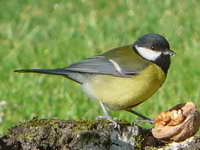


Tit,_Green-backed Parus monticolus
Description: The green-backed tit has a green back, blackish wings with 2 white wing-bars and blackish tail. It has a black head, throat, and median stripe on the yellow to lime underparts. The face is white. The green-backed tit is 113 cm long.
Range: Southern Asia and along the Himalayan foothills.
Habitat: Boreal forest, temperate forest. It favors oak trees.
Diet: Insects, larvae. Also fruits and seeds.
Conservation status: Least Concern.
Image by: 1, 2) Hiyashi Halso known as 3) Koshy_Koshy - IndiaRange: Southern Asia and along the Himalayan foothills.
Habitat: Boreal forest, temperate forest. It favors oak trees.
Diet: Insects, larvae. Also fruits and seeds.
Conservation status: Least Concern.
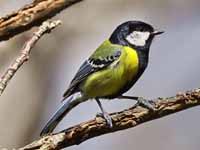

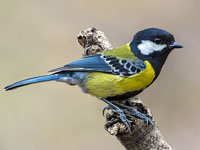
Tit,_Japanese Parus minor
Description: The Japanese tit has bluish-grey upperparts with white edgings and a greenish tinge to the upper-nape. It has a black hood, throat, and black median stripe on the underparts. The cheeks are white and the underparts are yellowish white. The Japanese tit is up to 15 minutes long. It is the eastern counterpart to the great tit.
Range: Far east Russia, Japan.
Habitat: Open deciduous woodland, mixed forests, forest edges and gardens.
Diet: Insects, larvae, spiders; also seeds and berries during the winter. The young are mainly fed caterpillars.
Conservation status: Least Concern.
Image by: 1, 3) Alpsdake - Japan 2) Lip Kee Yap - Minoo, Osalso, Japan 4) Greg_PetersonRange: Far east Russia, Japan.
Habitat: Open deciduous woodland, mixed forests, forest edges and gardens.
Diet: Insects, larvae, spiders; also seeds and berries during the winter. The young are mainly fed caterpillars.
Conservation status: Least Concern.


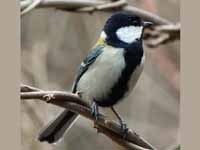
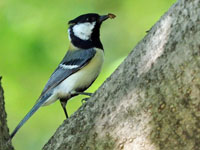
Genus Periparus
The Periparus tits are all found in Asia.
Tit,_Coal Periparus ater
Description: The coal tit has grey upperparts. It has a black head, nape, throat, and upper-breast. The rest of the underparts are white as are the cheeks. The subspecies P. a. melanolophus, the black-crested tit, has been previously considered to be a separate species. That subspecies has a black crest and grey underparts. The coal tit is about 11 cm long.
Range: Western Europe to eastern Asia, northern Africa.
Habitat: Conifer forests.
Diet: Insects including aphids, flies, bees, larvae, spiders, seeds.
Conservation status: Least Concern.
Image by: 1) Aviceda - Princetown, Devon, England
2) Stawomir Staszczuk 3) Cristiano Crolle - Switzerland 4) Shrikant_RaoRange: Western Europe to eastern Asia, northern Africa.
Habitat: Conifer forests.
Diet: Insects including aphids, flies, bees, larvae, spiders, seeds.
Conservation status: Least Concern.
4) P. a. melanolophus, the black-crested tit

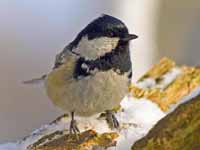


Tit,_Elegant Periparus elegans
Description: The elegant tit has mainly black upperparts with white edges to some feathers, white-wingbars, and a black mantle with elegant white and yellow markings. It has a black head and throat with a yellow face. The underparts are yellow. The elegant tit is about 12 cm long.
Range: The Philippines.
Habitat: Subtropical or tropical forests.
Diet: Insect, larvae; also seeds and fruit.
Conservation status: Least Concern.
Image by: 1) Francesco_VeronesiRange: The Philippines.
Habitat: Subtropical or tropical forests.
Diet: Insect, larvae; also seeds and fruit.
Conservation status: Least Concern.
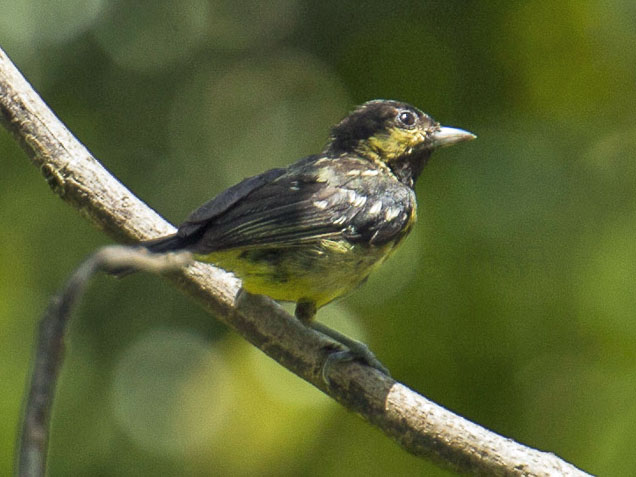
Tit,_Palawan Periparus amabilis
Description: The male Palawan tit has a black head, throat, and neck. It has a yellow back plus black-and-white wings and tail. The underparts are yellow. The female has olive back but otherwise similar to male. he male Palawan tit is up to 13 cm long.
Range: Palawan and some nearby Philippine islands.
Habitat: Lowland forest, including secondary forests, forest edge, swamps.
Diet: Insects, larvae, seeds, fruit.
Conservation status: It is listed as Near Threatened because of habitat loss from logging.
Image by: 1) Markaharper Range: Palawan and some nearby Philippine islands.
Habitat: Lowland forest, including secondary forests, forest edge, swamps.
Diet: Insects, larvae, seeds, fruit.
Conservation status: It is listed as Near Threatened because of habitat loss from logging.

Tit,_Rufous-naped Periparus rufonuchalis
Description: The rufous-naped tit, also known as the black-breasted tit, has a black crest and rest of the head except for its white face. It also has a black breast and black nape which might have a hint of rufous. The rest of the plumage is grey. The rufous-naped tit is about 13 cm long.
Range: India, China, Pakistan, Turkestan, Kyrgyzstan, and Afghanistan.
Habitat: Hilly conifer forests.
Diet: Insects and larvae, especially during the breeding season. Also fruit, seeds, nuts.
Conservation status: Least Concern.
Image by: 1, 2, 3) Imran_Shah - PakistanRange: India, China, Pakistan, Turkestan, Kyrgyzstan, and Afghanistan.
Habitat: Hilly conifer forests.
Diet: Insects and larvae, especially during the breeding season. Also fruit, seeds, nuts.
Conservation status: Least Concern.
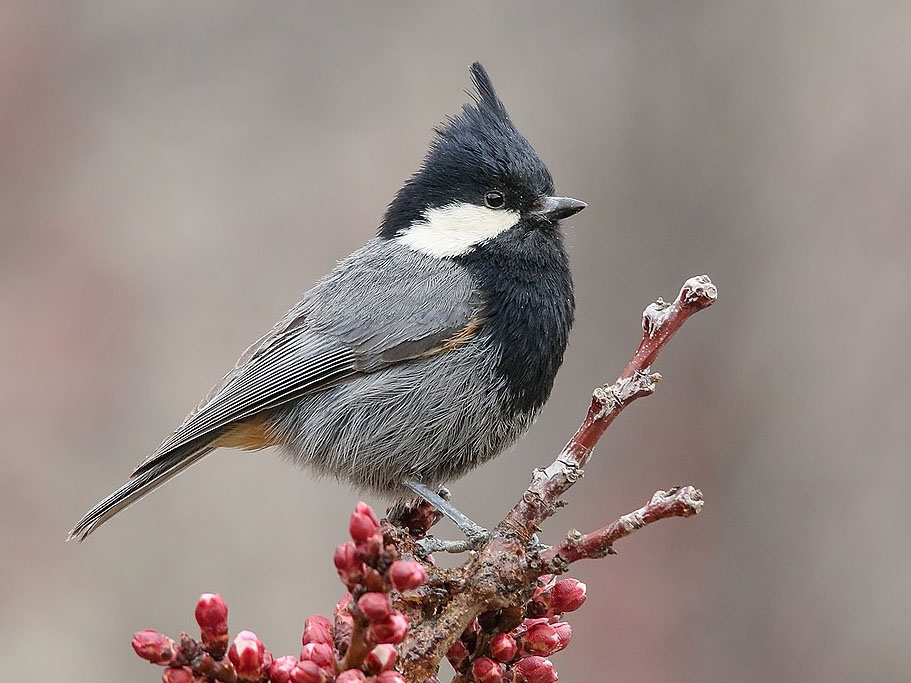
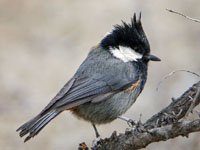
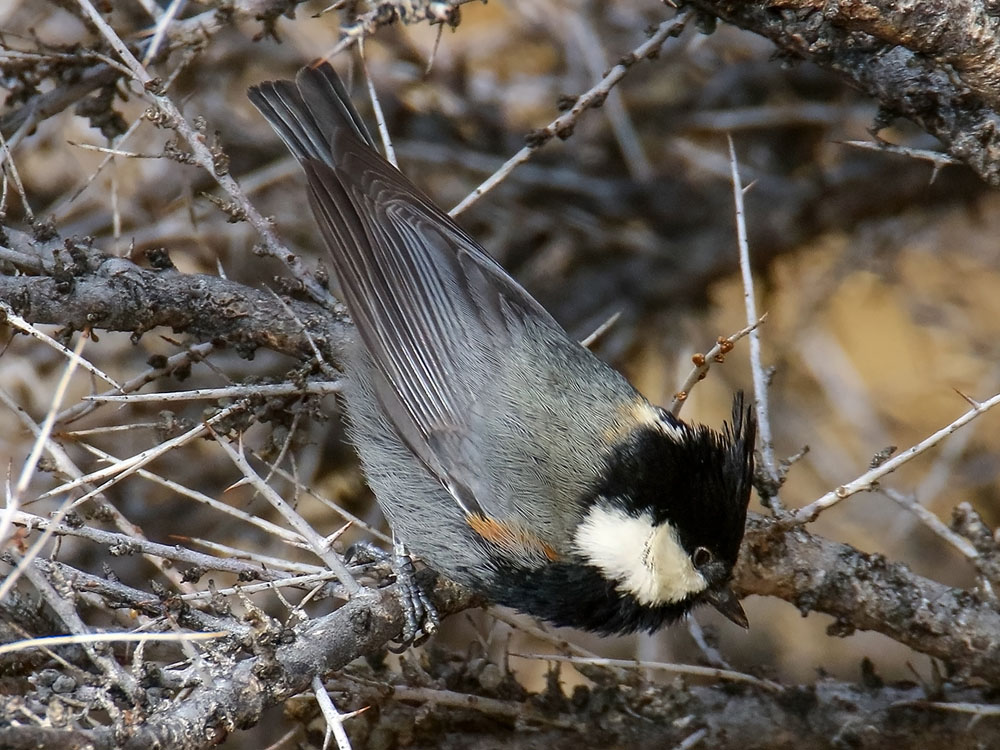
Tit,_Rufous-vented Periparus rubidiventris
Description: The rufous-vented tit has mainly grey upperparts, lighter underparts, rufous vent, black head with white cheeks, a black crest, and a black bib. The rufous-vented tit is up to 13 cm long. It is similar to the black-crested tit. The rufous-vented tit has lighter underparts t and also has a rufous-vent.
Range:. Western Himalaya east to Myanmar and north into China.
Habitat: Boreal forests and temperate forests.
Diet: Insects, larvae, seeds.
Conservation status: Least Concern.
Image by: 1) John Gould 2) Ron_Knight- Sichuan ChinaRange:. Western Himalaya east to Myanmar and north into China.
Habitat: Boreal forests and temperate forests.
Diet: Insects, larvae, seeds.
Conservation status: Least Concern.
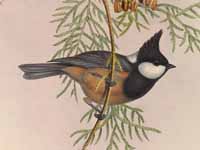

Tit,_Yellow-bellied Periparus venustulus also Pardaliparus venustulus
Description: The male yellow-bellied tit has a black head with white cheeks, and black throat. The upperparts are black with white tips and the wings are edges with yellow-olive. It has yellow underparts. The female has mostly yellow on the throat with black borders. Her head is more grey and the mantle olive, but the rest of her upperparts and underparts are similar to the male's. The yellow-bellied tit is up to 11 cm long.
Range: China.
Habitat: Moist lowland forests.
Diet: Insects, larvae, seeds.
Conservation status: Least Concern.
Image by: 1) Bernd_Kirschner 2) Ron_Knight - Sichuan 3) Dave CuritsRange: China.
Habitat: Moist lowland forests.
Diet: Insects, larvae, seeds.
Conservation status: Least Concern.

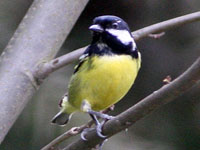
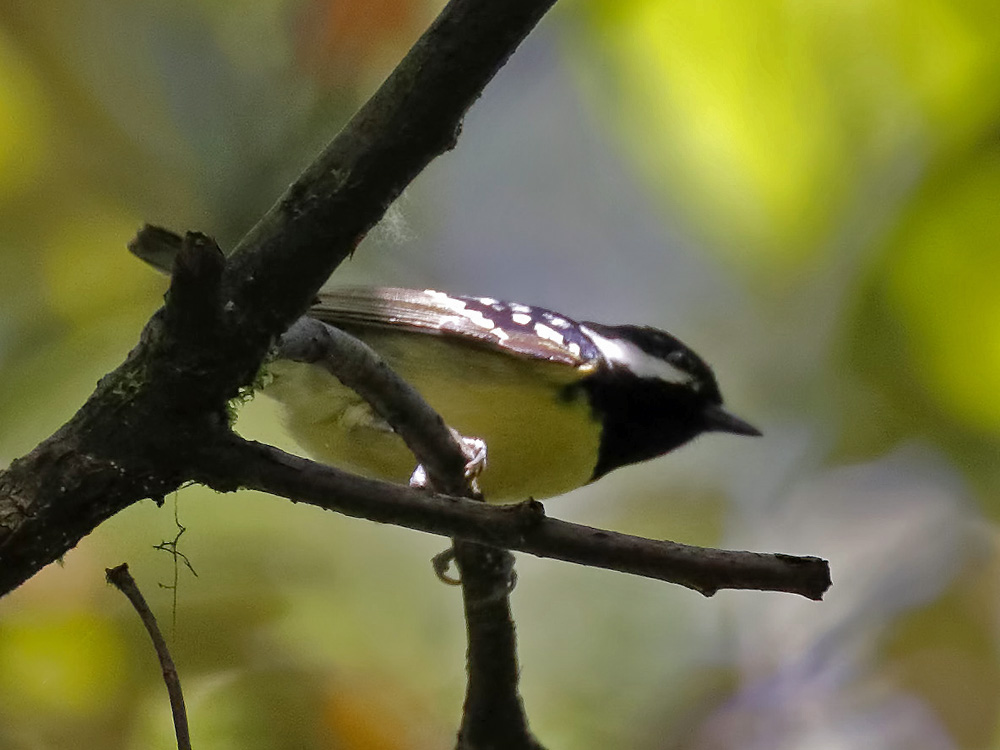
Genus Pseudopodoces - 1 species
Tit,_Ground Pseudopodoces humilis
Description: The ground tit has light brown upperparts, lighter grey-brown underparts, black, legs, long down-curved black bill.That down-curved bill is unusual for a tit. In general the ground tit is not tit-like in appearance and was put in this family because of DNA analysis. The Ground tit is about 20 cm long. The nest is created in a earthen banking.
Range: Southwest China, northeast India.
Habitat: Above the treeline in grassy areas which have some small bushes.
Diet: Probably insects and larvae.
Conservation status: Least Concern.
Image by: 1, 2) Dave_Curtis Dibyendu Ash - IndiaRange: Southwest China, northeast India.
Habitat: Above the treeline in grassy areas which have some small bushes.
Diet: Probably insects and larvae.
Conservation status: Least Concern.
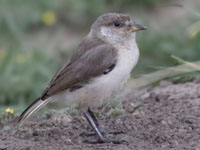


Genus Sittiparus
Tit,_Chestnut-bellied Sittiparus castaneoventris
Description: The chestnut-bellied tit has blue-grey upperparts. It has a black head with a white forehead and face. The throat is black and the underparts are chestnut. The chestnut-bellied tit is up to 13 cm long. It was conspecific with the
varied tit which looks very simiar. If found on Taiwan then it is a chestnut-bellied tit.
Range: Taiwan.
Habitat: Woodlands - either deciduous or mixed.
Diet: Insects, spiders, seeds, berries.
Conservation status: Least Concern.
Image by: 1)
John_and_Fish 2) Robert_tdc 3) Lin_Sun-FongRange: Taiwan.
Habitat: Woodlands - either deciduous or mixed.
Diet: Insects, spiders, seeds, berries.
Conservation status: Least Concern.
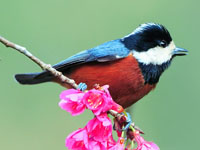

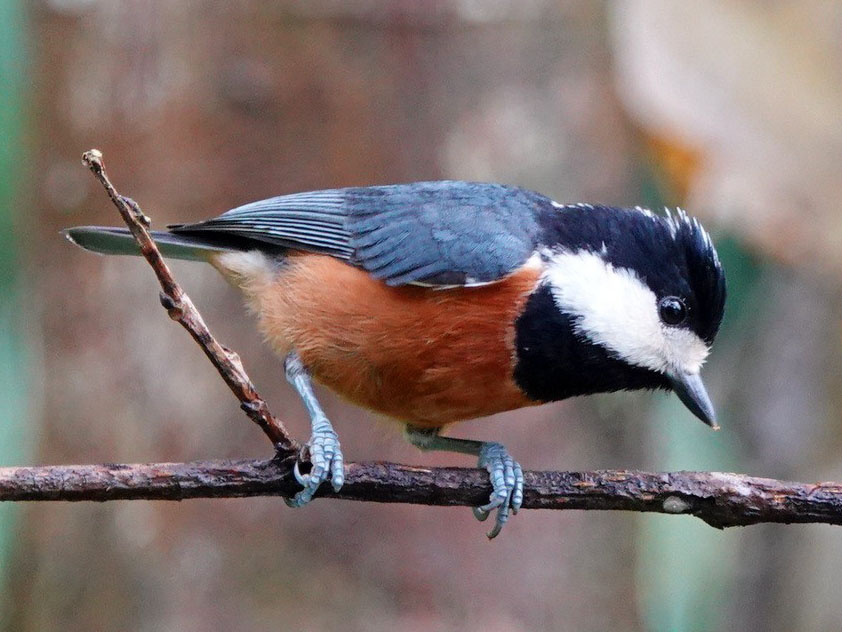
Tit,_Varied Sittiparus varius also Cyanistes varius
Description: The varied tit has a black crown, nape, throat, upper-breast, and bill. It has a white streak down the center of crown. It also has a white forehead, face, and cheeks. The back, wings, and tail are bluish-grey. The underparts are chestnut. The varied tit is up to 14 cm long.
Range: Japan, northeast China, Korea, and southeast Russia.
Habitat: Mixed woodlands including bamboo.
Diet: Insects, mainly caterpillars. Also seeds.
Conservation status: Least Concern.
Image by: 1) Alpsdake 2) M Nishimura 3) LonelyShrimpRange: Japan, northeast China, Korea, and southeast Russia.
Habitat: Mixed woodlands including bamboo.
Diet: Insects, mainly caterpillars. Also seeds.
Conservation status: Least Concern.
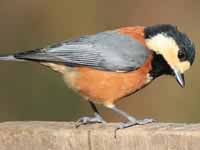
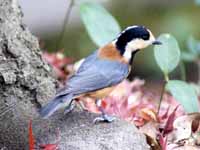
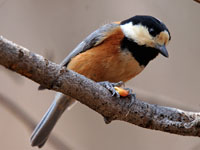
Tit,_White-fronted Sittiparus semilarvatus
Description: The white-fronted tit has mainly glossy black plumage. It has a white forehead and lores. The female is duller. The white-fronted tit is about 13 cm long.
Range: Luzon and Mindanao of the Philippine Islands.
Habitat: Forests and their edges, woodlands.
Diet: Probably insects and larvae.
Conservation status: It is listed as Near Threatened because of clearing of forests.
Image by: 1) John Gerrard Kuelemans Range: Luzon and Mindanao of the Philippine Islands.
Habitat: Forests and their edges, woodlands.
Diet: Probably insects and larvae.
Conservation status: It is listed as Near Threatened because of clearing of forests.

Genus Sylviparus - 1 species
Tit,_Yellow-browed Sylviparus modestus
Description: The yellow-browed tit has olive-green upperparts. The green head has a crest and the forehead is greyish, The upper-wings are grey-brown with yellow edges. The upper-tail is also grey-brown. It has greenish-yellow to pale greenish-grey underparts. At up to 10 cm long, the yellow-browed tit is the smallest tit.
Range: Southern Himalayas, northern India, southern China.
Habitat: Highland oak forests and mixed forests.
Diet: Probably insects, larvae, seeds.
Conservation status: Least Concern.
Range: Southern Himalayas, northern India, southern China.
Habitat: Highland oak forests and mixed forests.
Diet: Probably insects, larvae, seeds.
Conservation status: Least Concern.
Image by: 1) Francesco Veronesi - Bhutan 2) Dave_Curtis - Myanmar 3) Vijay_Ismavel - West Bengal
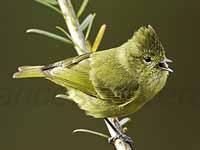

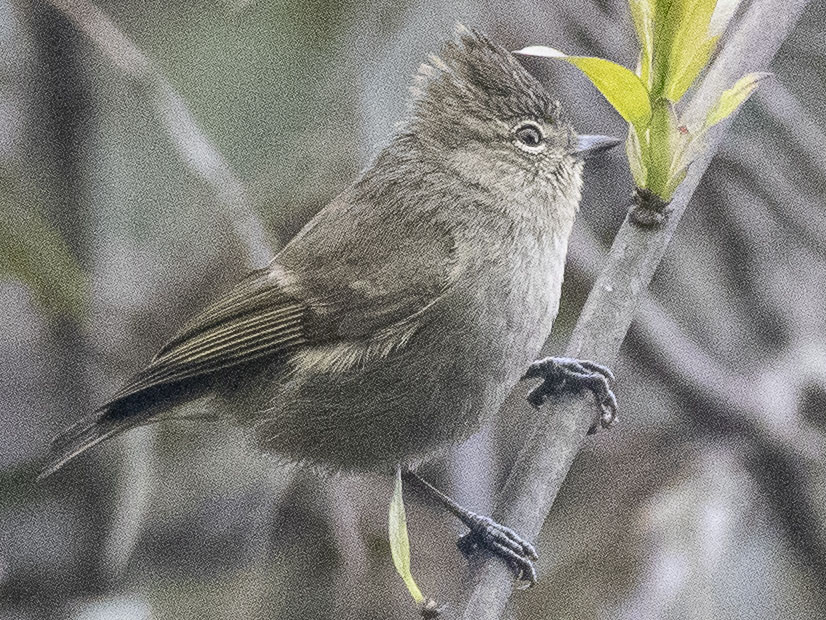
AFRICAN TITS
See also the African Blue Tit (Cyanistes teneriffae)Genus Melaniparus
These tits are from Africa and most have black and white plumage. They range from 12 to 18 cm long. The diet is similar to the other tit family members: insects, larvae, spiders plus fruits and seeds for some of the genus.
Tit,_Ashy Melaniparus cinerascens
Description: The ashy tit has grey upperparts and a black upper-tail. The black head has a broad white stripe below the eye. It has a black throat, bib, upper-breast, and under-tail. The lower-breast and belly are grey. The ashy tit is about 15 cm long. The similar grey tit has lighter underparts.
Range: Angola, Botswana, Namibia, South Africa, and Zimbabwe.
Habitat: Dry forests and also dry savanna.
Diet: Insects, larvae, spiders. Also fruits and seeds.
Conservation status: Least Concern.
Image by: 1, 2, 3) Derek_Keats - Botswana Range: Angola, Botswana, Namibia, South Africa, and Zimbabwe.
Habitat: Dry forests and also dry savanna.
Diet: Insects, larvae, spiders. Also fruits and seeds.
Conservation status: Least Concern.
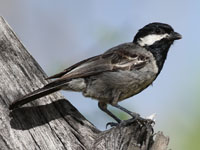

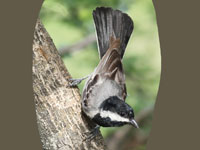
Tit,_Carp's Melaniparus carpi
Description: The Carp's tit has mainly black plumage. There is a substantial amount of white on the wings. It has a small black bill and grey legs. The Carp's tit is about 18 cm long.
Range: Angola, Namibia.
Habitat: Dry woodlands, savanna.
Diet: Insects, larvae, spiders; also seeds.
Conservation status: Least Concern.
Image by: 1, 2) Jerry Oldenettel - Namibia Range: Angola, Namibia.
Habitat: Dry woodlands, savanna.
Diet: Insects, larvae, spiders; also seeds.
Conservation status: Least Concern.
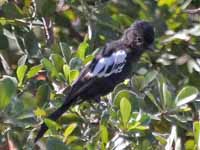
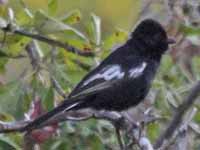
Tit,_Dusky Melaniparus funereus
Description: The dusky tit has slate-grey plumage with the upperparts darker than the underparts. It has red eyes, a black bill, and dark legs. The dusky titis about 14 cm long.
Range: Central Africa.
Habitat: Evergreen woodlands and surroundings.
Diet: Insects, larvae; also fruits and seeds.
Conservation status: Least Concern.
Image by: 1) John Gerrard Keulemans 2) Dick Daniels - specimen in Nairobi National Museum, Kenya 3) Nik_Borrow - UgandaRange: Central Africa.
Habitat: Evergreen woodlands and surroundings.
Diet: Insects, larvae; also fruits and seeds.
Conservation status: Least Concern.

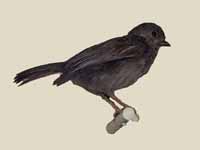
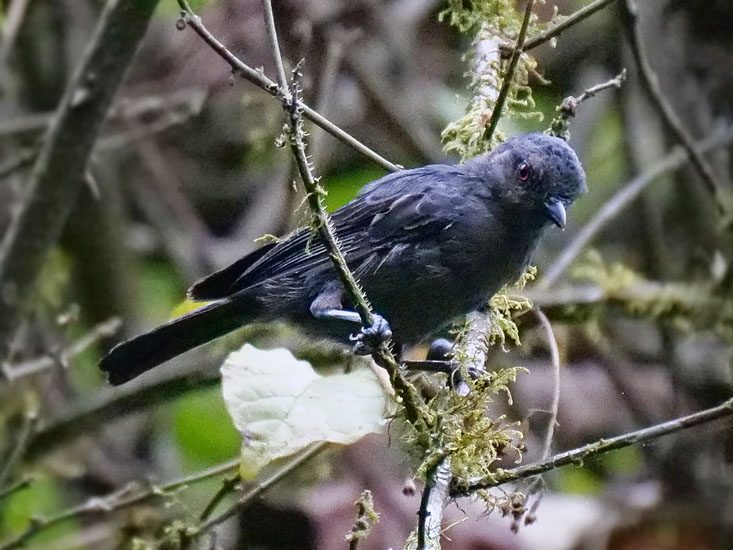
Tit,_Grey Melaniparus afer
Description: The grey tit has grey upperparts. It has a black head with a wide white stripe below the eyes. It has a black throat, bib, upper-breast, and upper-tail. The rest of the underparts are light grey. The grey tit is up to 15 cm long. The similar ashy tit has darker underparts than the grey tit.
Range: Lesotho, Namibia, South Africa.
Habitat: Dry area such a scrubland and other areas of short vegetation.
Diet: Insects including wasps, caterpillars, insect larvae.
Conservation status: Least Concern.
Image by: 1, 2) Alan Manson - South Africa 3) Francesco Veronesi Range: Lesotho, Namibia, South Africa.
Habitat: Dry area such a scrubland and other areas of short vegetation.
Diet: Insects including wasps, caterpillars, insect larvae.
Conservation status: Least Concern.
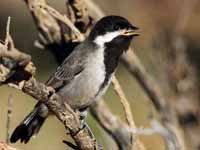
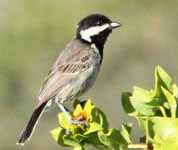

Tit,_Miombo Melaniparus griseiventris
Description: The miombo tit has grey upperparts with black and white wings plus a black tail. It has a mainly black head with a white face and black bib that extends, narrowing as it goes, down the underparts which are mostly white. The under-tail is black as is the bill. The miombo tit is up to 15 cm long.
Range: Mainly southern Africa.
Habitat: Miombo woodlands.
Diet: Probably insects and larvae.
Conservation status: Least Concern.
Image by: 1) Maans_Booysen - Angola Range: Mainly southern Africa.
Habitat: Miombo woodlands.
Diet: Probably insects and larvae.
Conservation status: Least Concern.
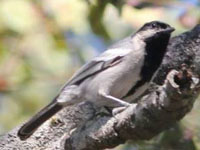
Tit,_Red-throated Melaniparus fringillinus
Description: The red-throated tit has grey upperparts with black wings that have white edgings. Except for a black cap, the head, throat, and breast are red. The belly is grey. The female is duller than the male, The red-throated tit is about 12 cm long.
Range: Kenya, Tanzania.
Habitat: Dry savanna.
Diet: Insects, larvae; also fruits and seeds.
Conservation status: Least Concern.
Image by: 1) Francesco_Veronesi - Kenya 2, 3) Nik_Borrow - Tanzania Range: Kenya, Tanzania.
Habitat: Dry savanna.
Diet: Insects, larvae; also fruits and seeds.
Conservation status: Least Concern.
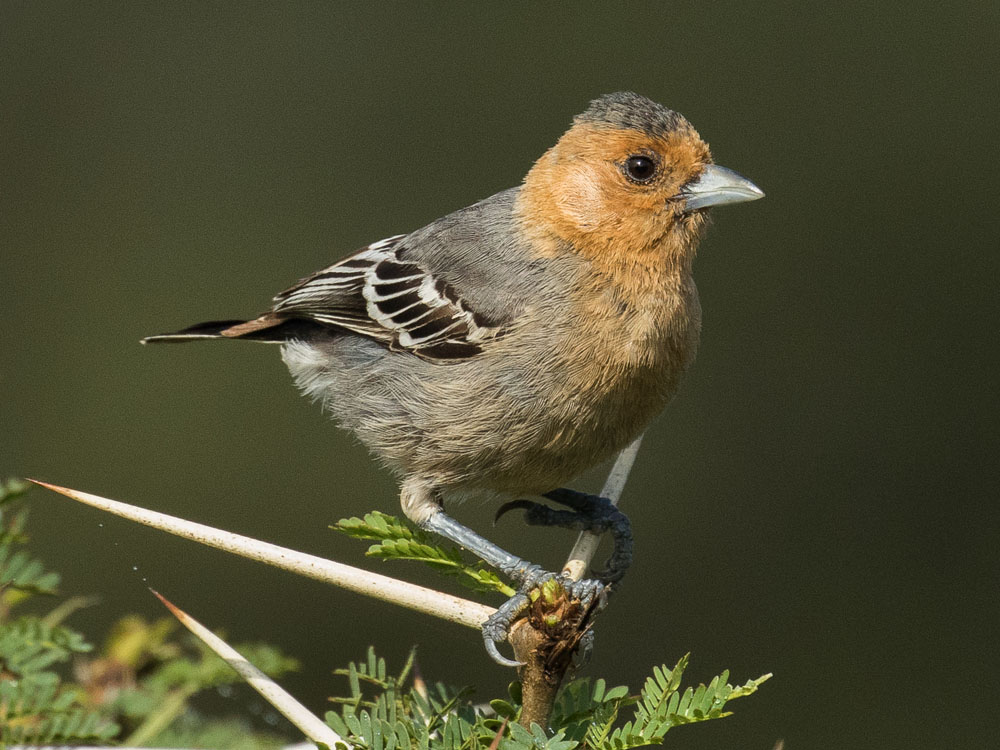
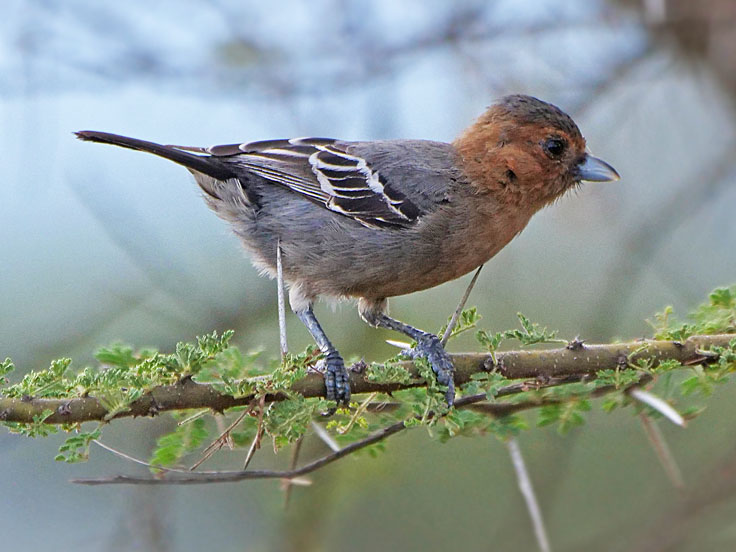

Tit,_Rufous-bellied Melaniparus rufiventris
Description: The rufous-bellied tit has grey upperparts. It has a black head, breast, wings, and tail, The belly is rufous. The rufous-bellied tit is up to 16 cm long.
Range: Tanzania and Angola south to northern Botswana.
Habitat: Dry miombo forests.
Diet: Insects, larvae.
Conservation status: Least Concern.
Image by: 1) Nigel_Voaden - DR Congo 2) Peter_Steward - Malawi 3) Maans_Booysen - AngolaRange: Tanzania and Angola south to northern Botswana.
Habitat: Dry miombo forests.
Diet: Insects, larvae.
Conservation status: Least Concern.
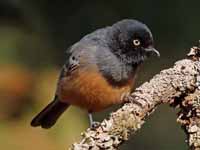
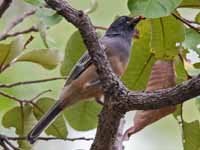
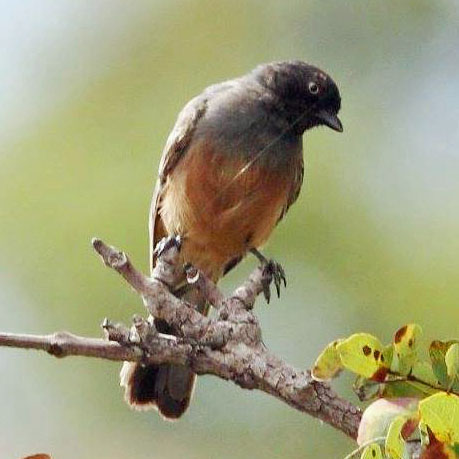
Tit,_Somali Melaniparus thruppi
Description: The Somali tit, also known as the acacia tit, has grey upperparts with some white edgings and a black upper-tail. It has a black head, white face, and black bib that extends to a black breast strip. The rest of the underparts are pale grey. The Somali tit is about 12 cm long.
Range: Northeastern Africa.
Habitat: Dry acacua woodland.
Diet: Wasps, beetles, other insects and their larvae.
Conservation status: Least Concern.
Range: Northeastern Africa.
Habitat: Dry acacua woodland.
Diet: Wasps, beetles, other insects and their larvae.
Conservation status: Least Concern.
Image by: 1) Francesco_Veronesi - Kenya 2) Nik_Borrow - Ethiopia
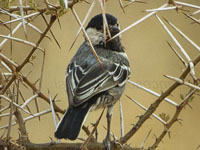

Tit,_Southern Black- Melaniparus niger
Description: The male southern black-tit, also known as the black tit, has bluish-black plumage with white on the wings. The female is more greyish with white on wings. The southern black tit is up to 16 cm long.
Range: Botswana, South Africa, Zimbabwe.
Habitat: Broad-leafed woodlands.
Diet: Mainly insects, especially wasps. Also some fruit.
Conservation status: Least Concern.
Image by: 1) Derek_Keats - South Africa 2) Haller1962 3) Franceso Veronesi 4) Ron Knight 4) Lip KeeRange: Botswana, South Africa, Zimbabwe.
Habitat: Broad-leafed woodlands.
Diet: Mainly insects, especially wasps. Also some fruit.
Conservation status: Least Concern.
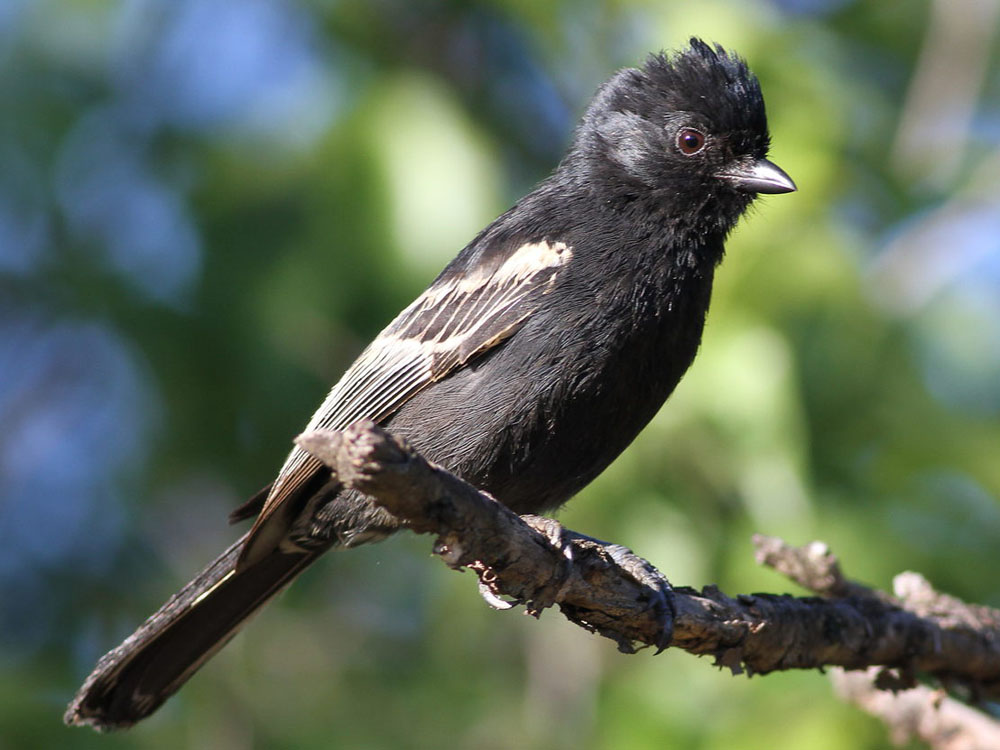
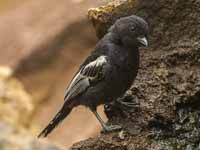
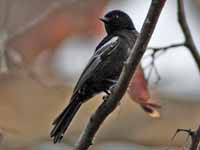
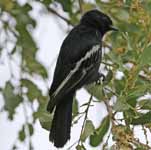
Tit,_Stripe-breasted Melaniparus fasciiventer
Description: The stripe-breasted tit has grey upperparts. The head, throat, and upper-breast are usually black, but may be grey. The lower-breast and belly are pale grey and there is a black breast-stripe. The stripe-breasted tit is 14 to 15 cm long.
Range: Burundi, DR Congo, Rwanda, Uganda.
Habitat: Moist montane forests.
Diet: Insects, larvae, caterpillars.
Conservation status: Least Concern.
Image by: 1, 2) Nik_Borrow - UgandaRange: Burundi, DR Congo, Rwanda, Uganda.
Habitat: Moist montane forests.
Diet: Insects, larvae, caterpillars.
Conservation status: Least Concern.
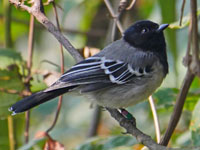

Tit,_White-backed_Black- Melaniparus leuconotus
Description: The white-backed black-tit, except for a white mantle, has all black plumage. It is about 14 cm long.
Range: Eritrea, Ethiopia.
Habitat: Boreal forests, scrubland, and even bamboo. Usually found between 1500 and 3000 meters.
Diet: Probably insects and their larvae.
Conservation status: Least Concern.
Image by: 1, 2) Nik_Borrow - EthiopiaRange: Eritrea, Ethiopia.
Habitat: Boreal forests, scrubland, and even bamboo. Usually found between 1500 and 3000 meters.
Diet: Probably insects and their larvae.
Conservation status: Least Concern.


Tit,_White-bellied Melaniparus albiventris
Description: The white-bellied tit has a black mantle, head, breast, and tail. The lower back and wings are a mix of black and white. It has a white belly, The white-bellied tit is up to 15 cm long.
Range: Mainly Kenya and Tanzania; also south Sudan. There is a disjoint popution in the western countries of Nigeria and Cameroon.
Habitat: Acacia woodlands, grasslands with trees available, montane forest edges.
Diet: Insects, larvae, spiders, seeds.
Conservation status: Least Concern.
Image by: 1) Peter Steward - Kenya 2) Dominic_SheronyRange: Mainly Kenya and Tanzania; also south Sudan. There is a disjoint popution in the western countries of Nigeria and Cameroon.
Habitat: Acacia woodlands, grasslands with trees available, montane forest edges.
Diet: Insects, larvae, spiders, seeds.
Conservation status: Least Concern.

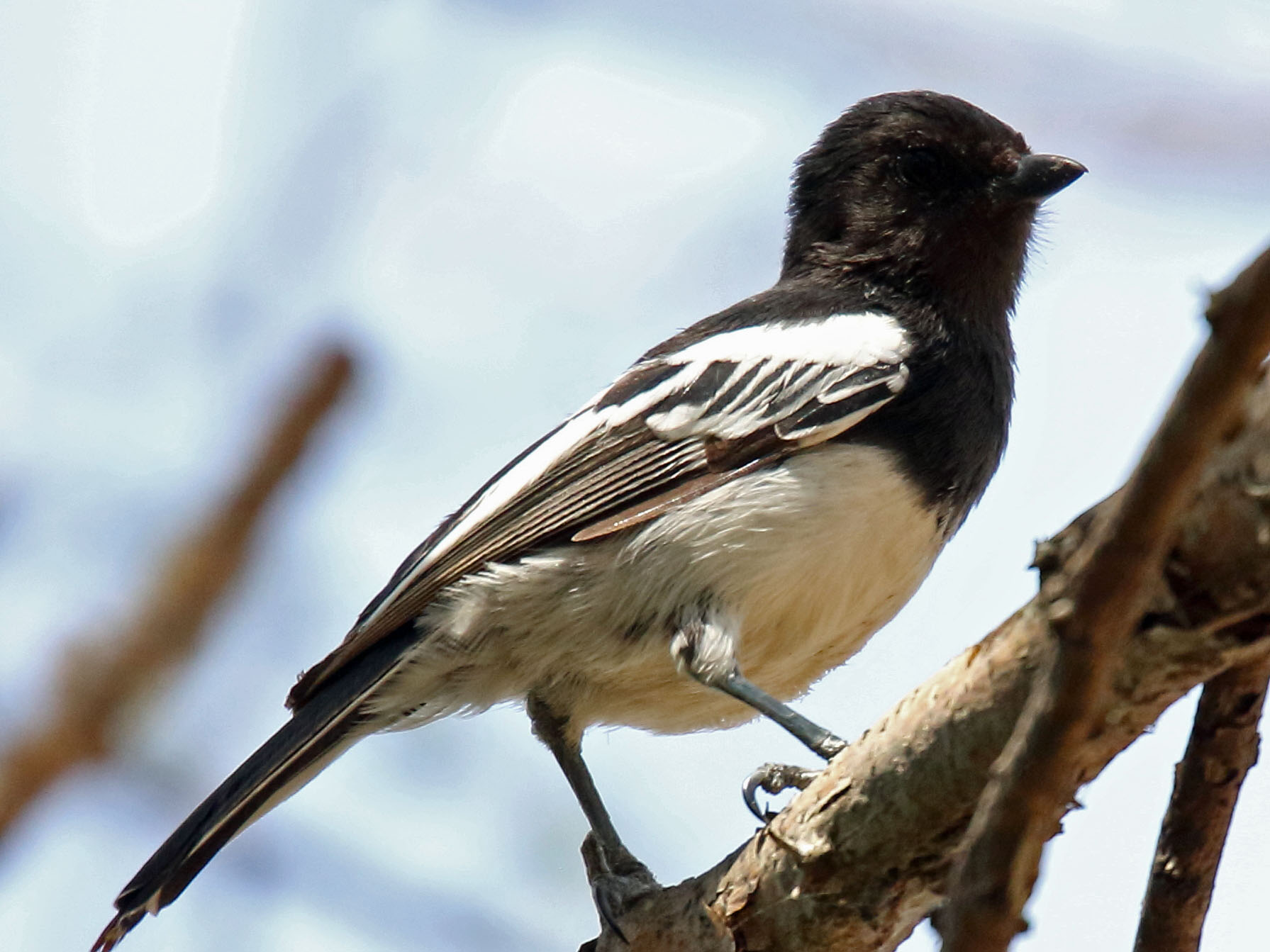
Tit,_White-shouldered Black- Melaniparus guineensis
Description: The white-shouldered black tit has mainly black plumage, a white wing patch, and pale eyes. It is 14 cm long. The similar white-winged black-bit. has dark eyes.
Range: Central Africa.
Habitat: Coniferous forests.
Diet: Insects, larvae, seeds and some fruit.
Conservation status: Least Concern.
Image by: 1) Allan_Hopkins - Gambia 2) Nik_Borrow - GhanaRange: Central Africa.
Habitat: Coniferous forests.
Diet: Insects, larvae, seeds and some fruit.
Conservation status: Least Concern.

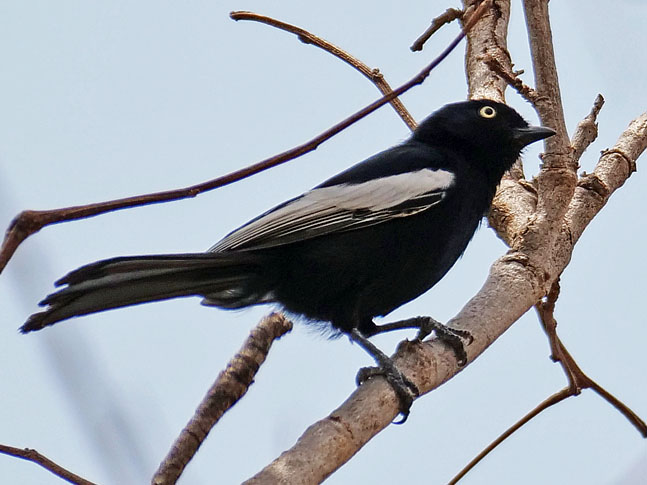
Tit,_White-winged_Black- Melaniparus leucomelas
Description: The white-winged black-tit has mainly black plumage. It has white wing patch and dark eyes. The white-winged black-tit is up to 16 cm long. The similar white-shouldered black-tit has pale eyes.
Range: From Angola in the west to Ethiopia in the east.
Habitat: Dry forests, savanna.
Diet: Insects, larvae; some seeds.
Conservation status: Least Concern.
Image by: 1) Nik_Borrow 2) Charles_Davies - Angola 3) Peter_WiltonRange: From Angola in the west to Ethiopia in the east.
Habitat: Dry forests, savanna.
Diet: Insects, larvae; some seeds.
Conservation status: Least Concern.
